Ultimate DIY Movable Chicken Coop | Running Gear Egg Mobile Build
The Joel Salatin egg mobile concept has been on our radar for some time. These mobile coops can be scaled to work on any farm or homestead. This spring, we built our 8’ x 12’ egg mobile to hold a flock of 50-100 chickens. It turned out better than we ever dreamed and we’ll share everything you need to know to design and build your own movable chicken coop.
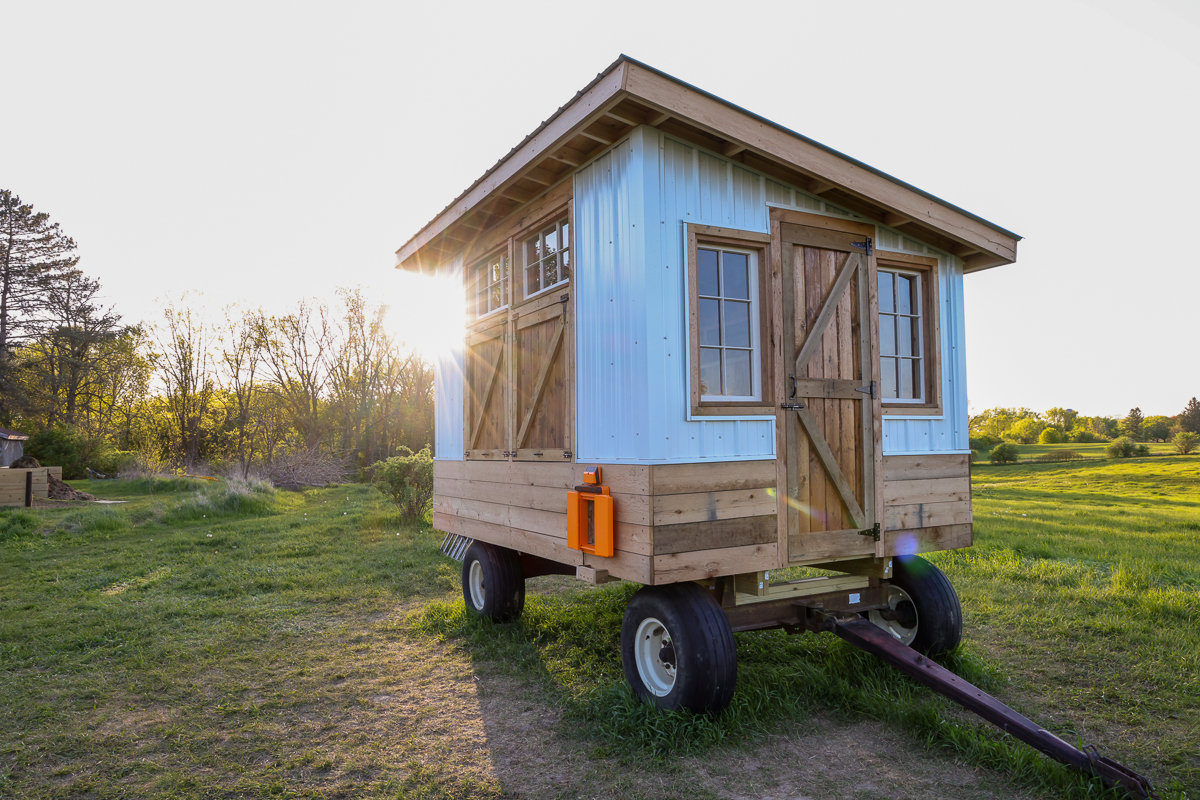
In fact, we documented the whole month-long build in this video below. It shows the nitty gritty details of how we built it, start to finish, what thought went into the design, and lessons learned along the way.
And if you’re not quite sure if a full fledged hay wagon or running gear egg mobile is right for you, check out our other posts where we turned an outdoor kids playset into an A-frame chicken tractor, our modified Suscovich chicken tractor plans for 25 meat chickens, or our simple chicken coop we built inside our pole barn.
What is an Egg Mobile?
An egg mobile is simply a mobile chicken coop for laying hens. Key features include the coop being built on wheels and often they include an open floor design where the chicken poop falls direclty through to the ground.
Joel Salatin may not have been the originator, but he certainly made known the ways of the egg mobile far and wide.

Joel’s egg mobiles at Polyface Farm look different than ours—they’re bigger and designed to house hundreds of chickens, integrating them into their rotational grazing systems. Many have scaled down that concept for smaller farms and homesteads, and built a chicken coop structure on top of a hay wagon, or, in its base form, a running gear.
Why an Egg Mobile?
Mobile chicken coops make a lot of sense. Here are some of the top reasons we chose to build ours.
- Free Range Fatigue – If you’ve free ranged your laying hens before, you know that they get into everything. Your garden, potted plants, the kids’ play spaces. Not only can they do a lot of damage to plants and your lawn, but the poop—it’s everywhere! Often an egg mobile is accompanied by some form of fencing or netting to keep reckless ranging at bay.
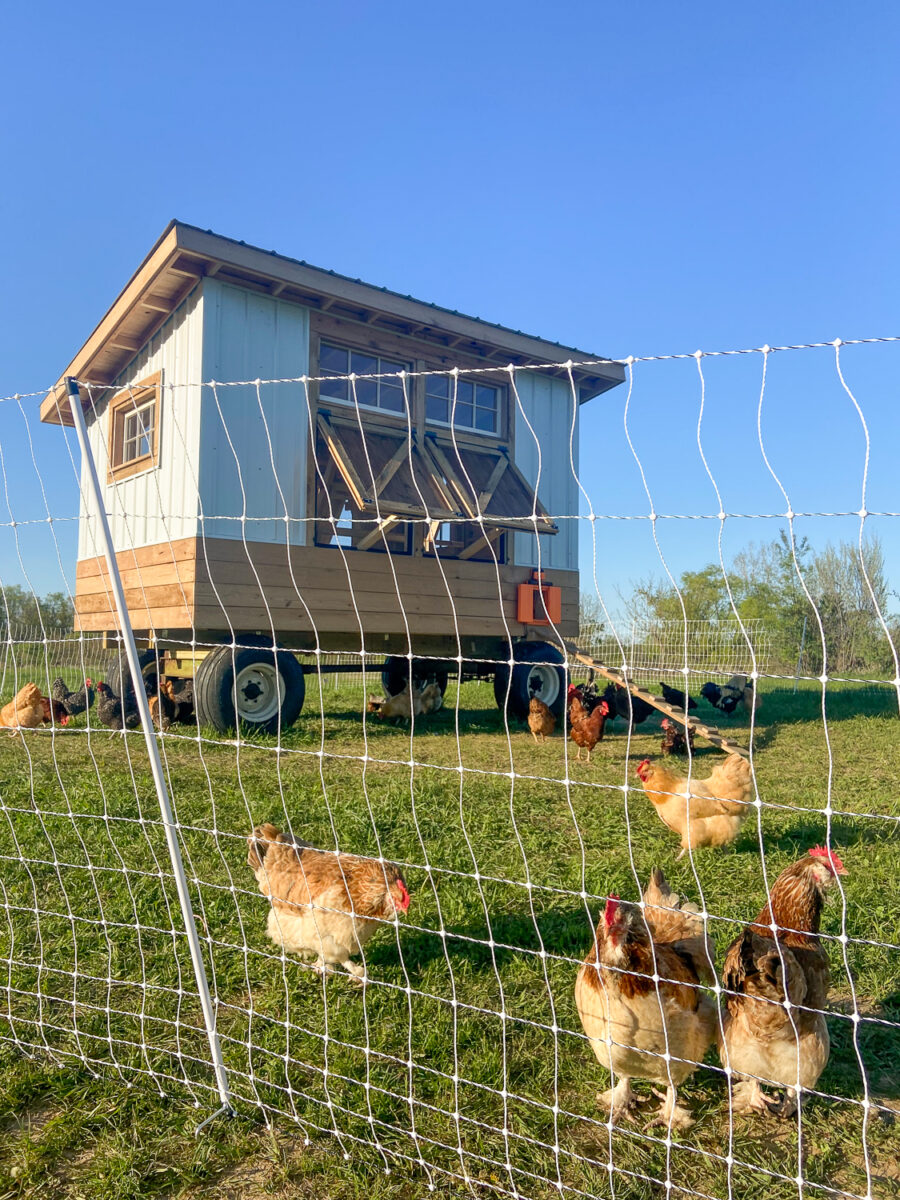
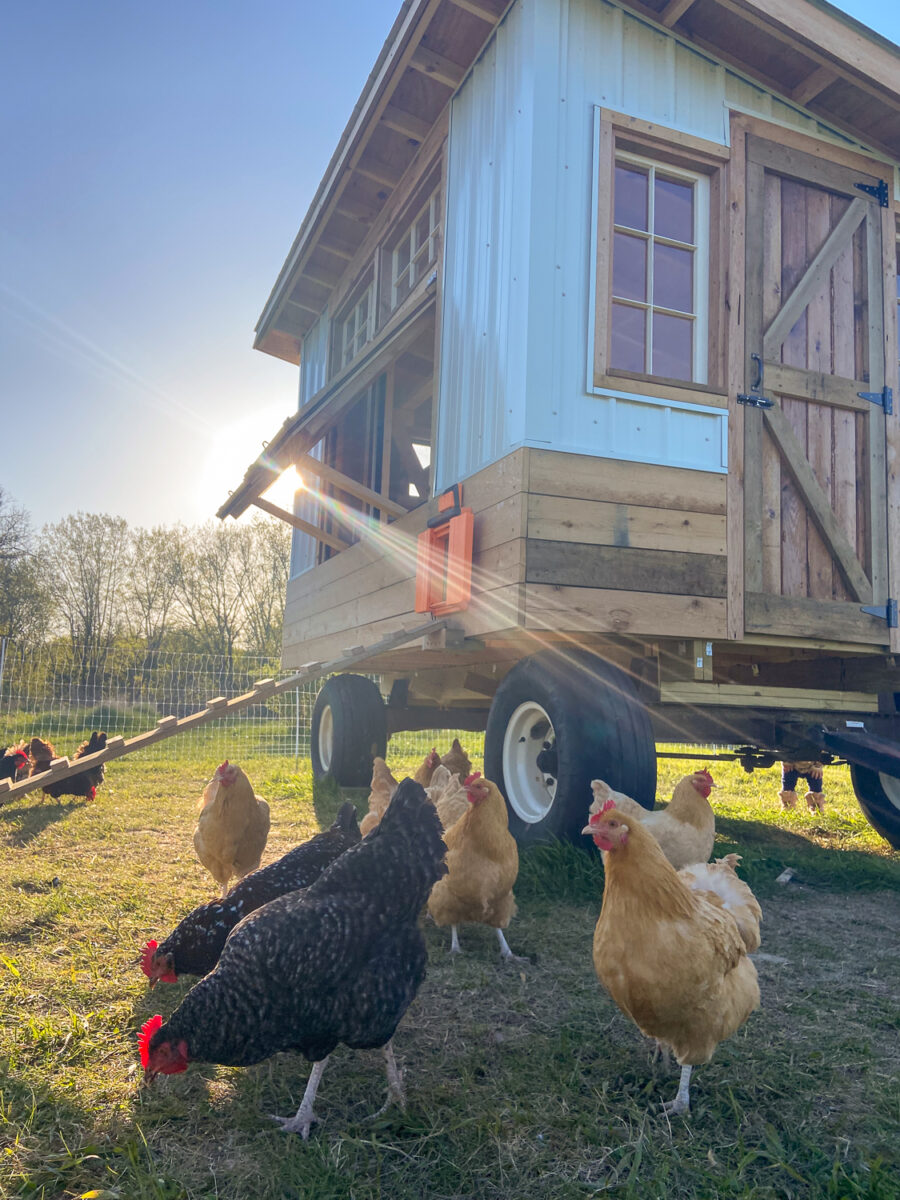
- Mimics Nature – You don’t need grazing animals to build an egg mobile. But if you practice rotational grazing, you might as well integrate your chickens. Cows, or other grazing animals, drop manure, flies lay larvae in the manure, chickens follow a few days behind and eat the maggots. Win-win. Fewer flies. Free chicken protein. All while mimicking natural systems where birds follow behind grazing animals.
- Fertilization – Not only do the chickens help to spread livestock manure as described above, but they also drop their own manure along the way. Since the coop moves regularly, there is no concentrated chicken manure buildup and your pasture is naturally fertilized.
- Multi-Species – All animals browse and/or graze differently. More species can generally lead to a healthier pasture as each manage the land according to their strengths. Chickens can scratch and pull up much of the dead undergrowth to help pastures thrive and not be suppressed.
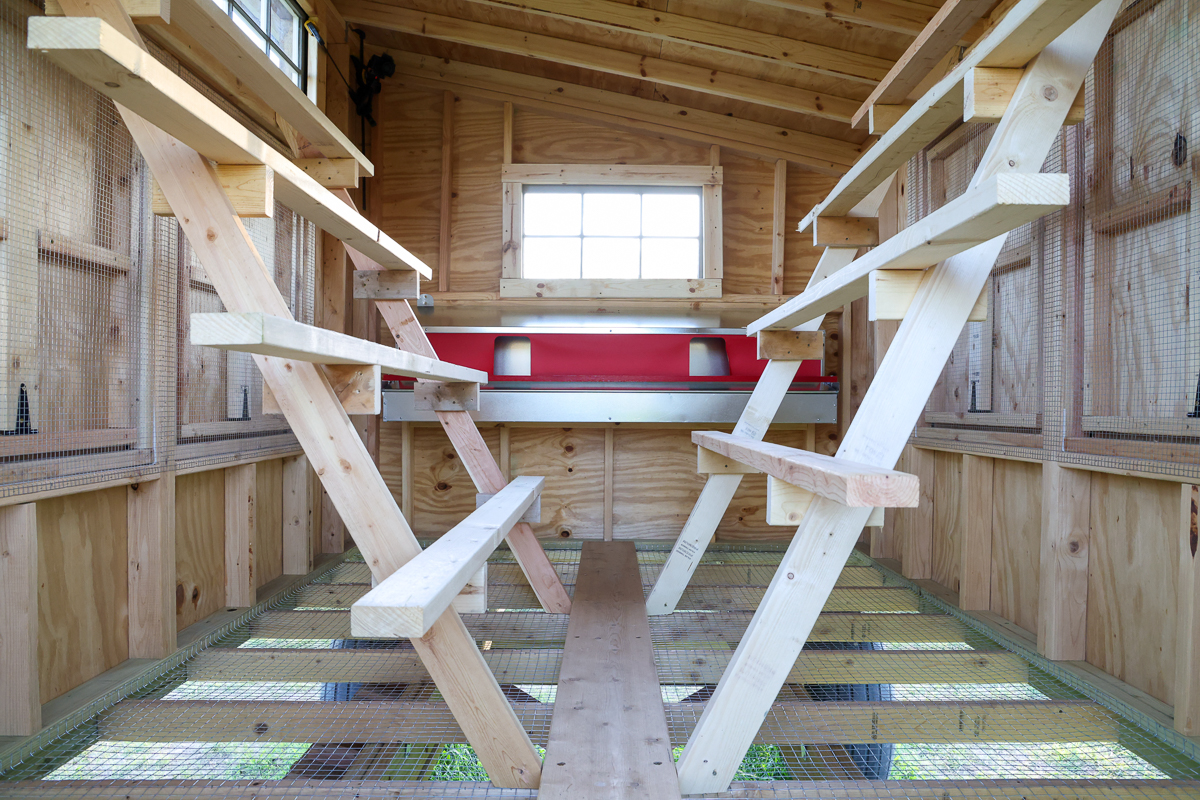
- No Permit Needed – Often, chicken coops or larger fixed structures require some form of permit with your local municipality. But not with a mobile coop!
- Bring It With – When life takes you in a different direction and you find yourself moving, your egg mobile will be the best investment you could make. Just pull your whole setup and chickens right along with you.
Mobile Chicken Coop Design Considerations
We set out to build a chicken coop that looked good, was built to last, and was laid out efficiently. You’ll definitely want to give your egg mobile design some good thought.
Size/Scale
Getting the size of your chicken coop correct is the most important. How many chickens do you have? How many might you have in the future? How much space or land do you have to pull and maneuver a mobile structure? What are you pulling it with and how much weight can it handle?
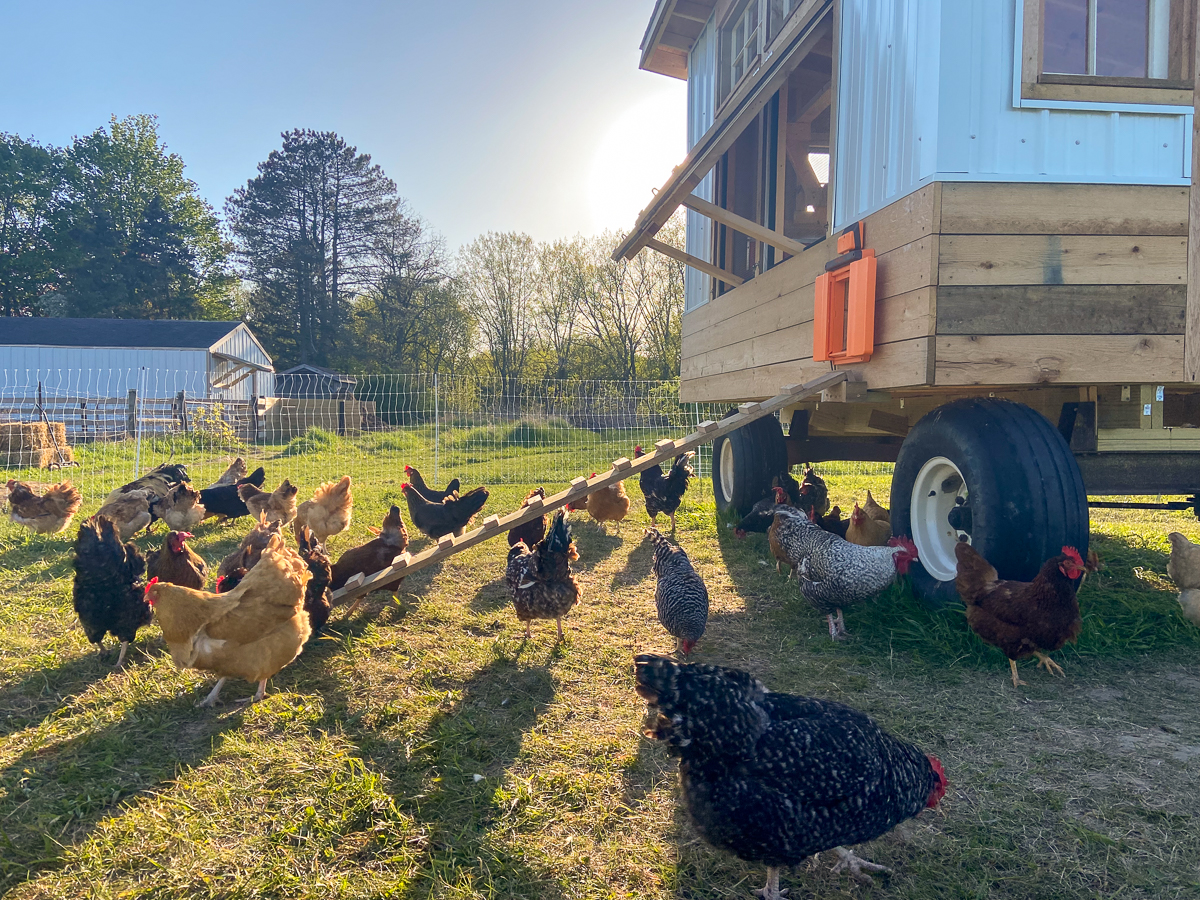
Our egg mobile is 8’ wide by 12’ long. We pull it with our Kubota compact tractor around our back 3.5 acres of pasture.
This size feels right for us. Not too massive, but big enough to fit the 50 or so laying hens we typically have on our homestead with capacity up to 100.
Floor
Flooring can make or break an egg mobile design. They’re typically designed with some sort of mesh or grated flooring to allow all the chicken poop from your flock to pass through to the grass below.
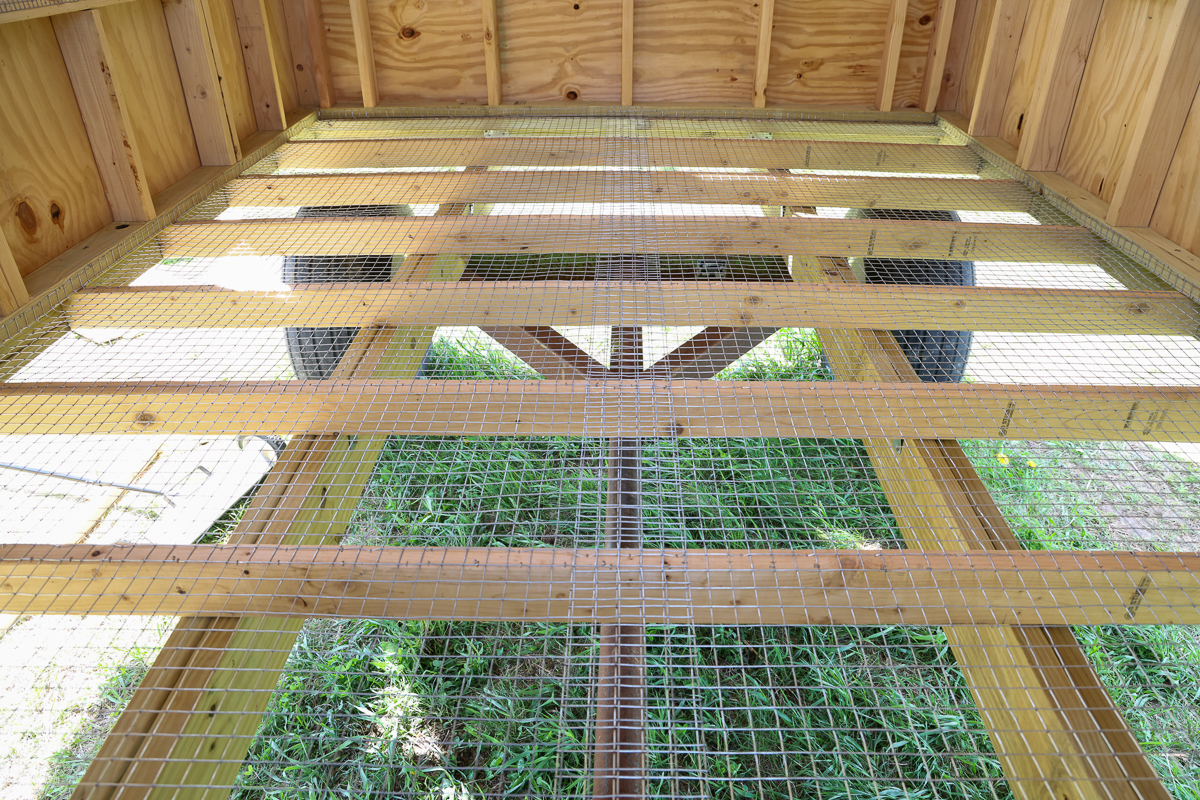
Most designs I saw out there called for expanded metal—the diamond patterned grated metal you commonly see on things like trailers. While it makes a sturdy walking surface, some expanded metal has larger openings than others and I talked to some who had bad experiences of the chicken poop caking up on the floor creating a perpetural mess.
We went with 1”x1” hardware cloth. It’s very thin, so poop easily passes through the grid. The hardware cloth is not 100% ideal for foot traffic, but 95% of the foot traffic is on the 2×10 plank down the center of the coop.
Airflow
The ability to open up your coop for airflow on warm days, but seal it up when it’s cooler, is important.
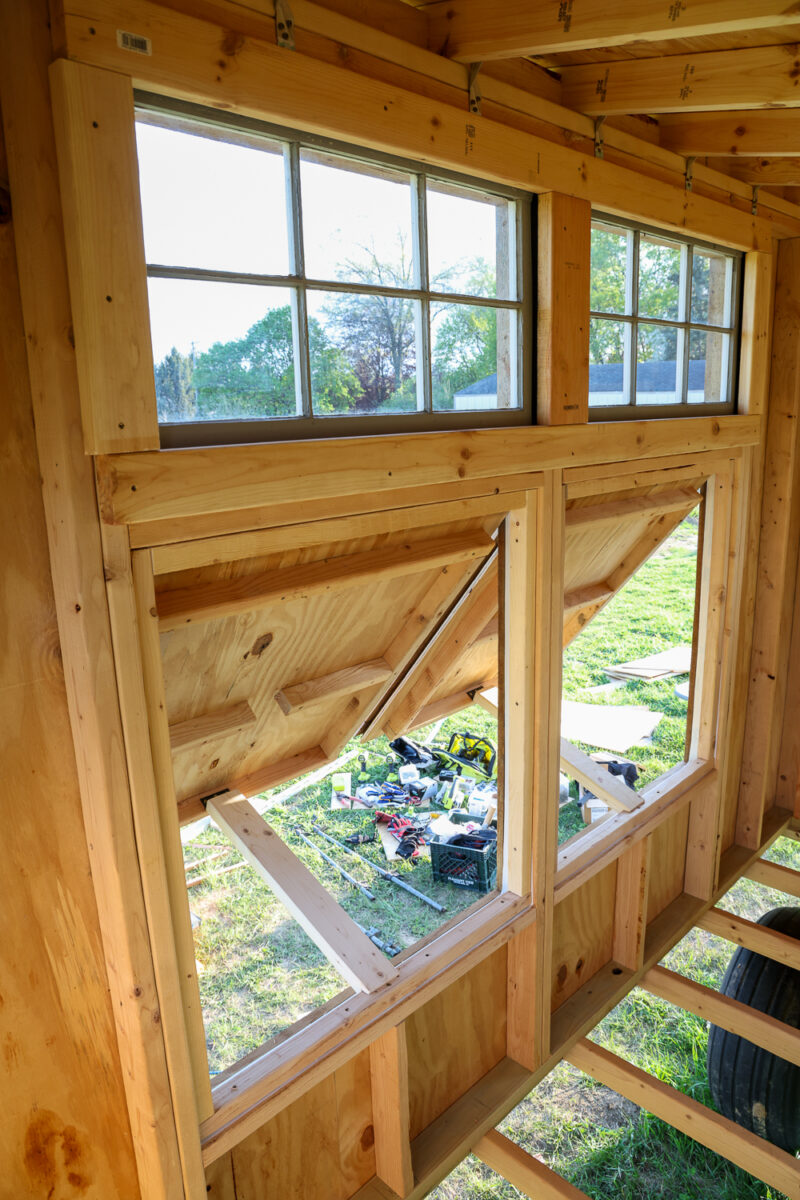
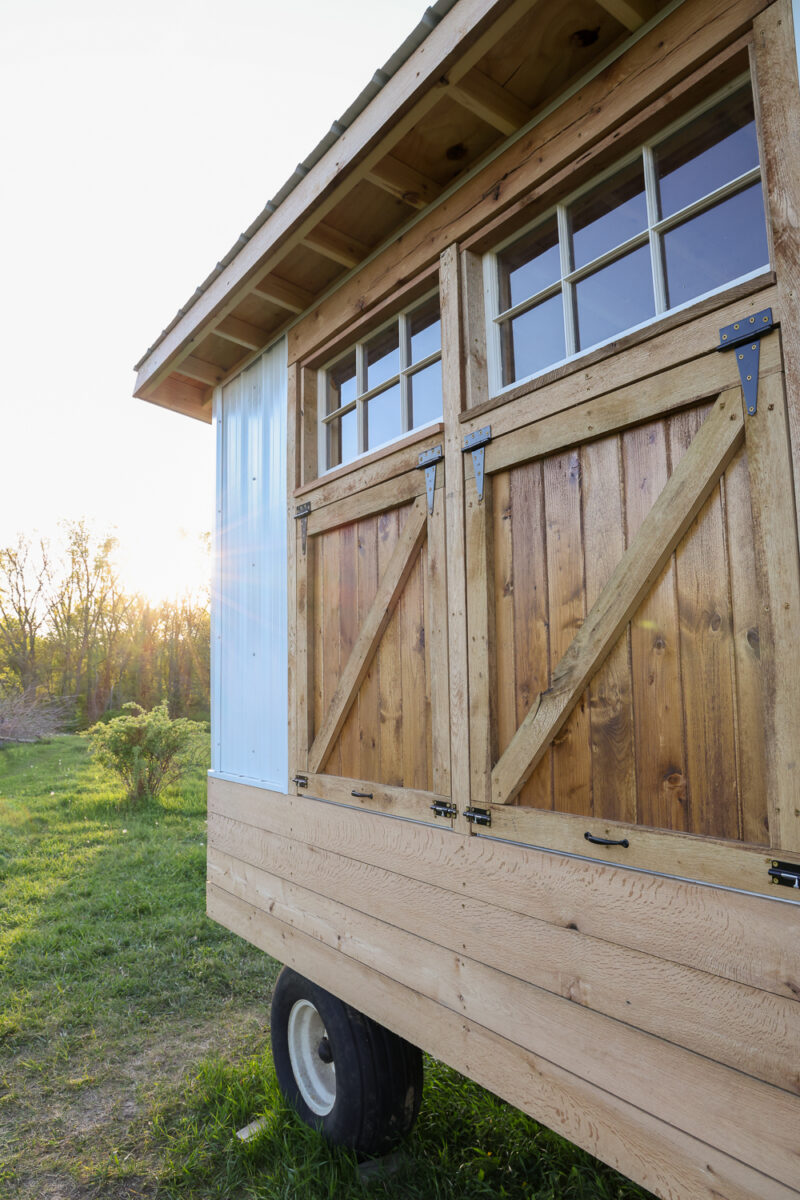
We added two air vent panels on each side of the coop, allowing for ample airflow in the summertime. Each panel is also lined with 1/2” hardware cloth so the coop is sealed up from predators while the vents are open.
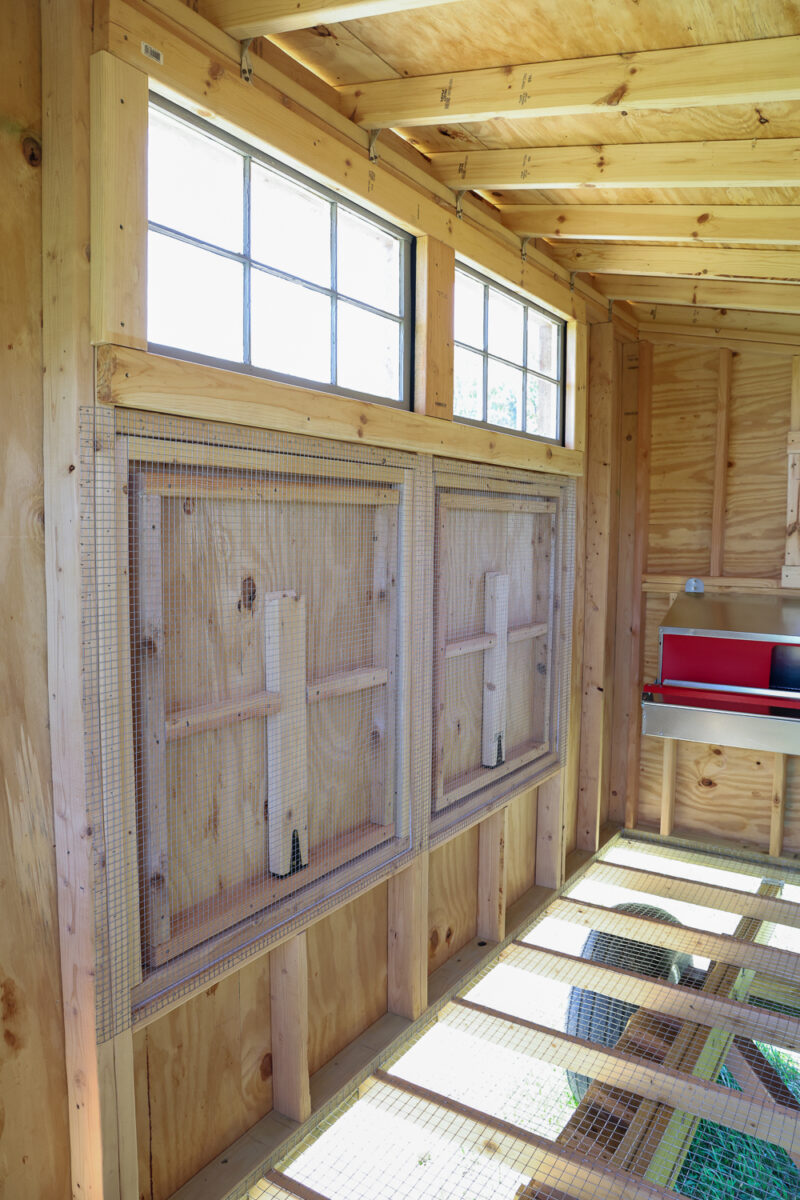
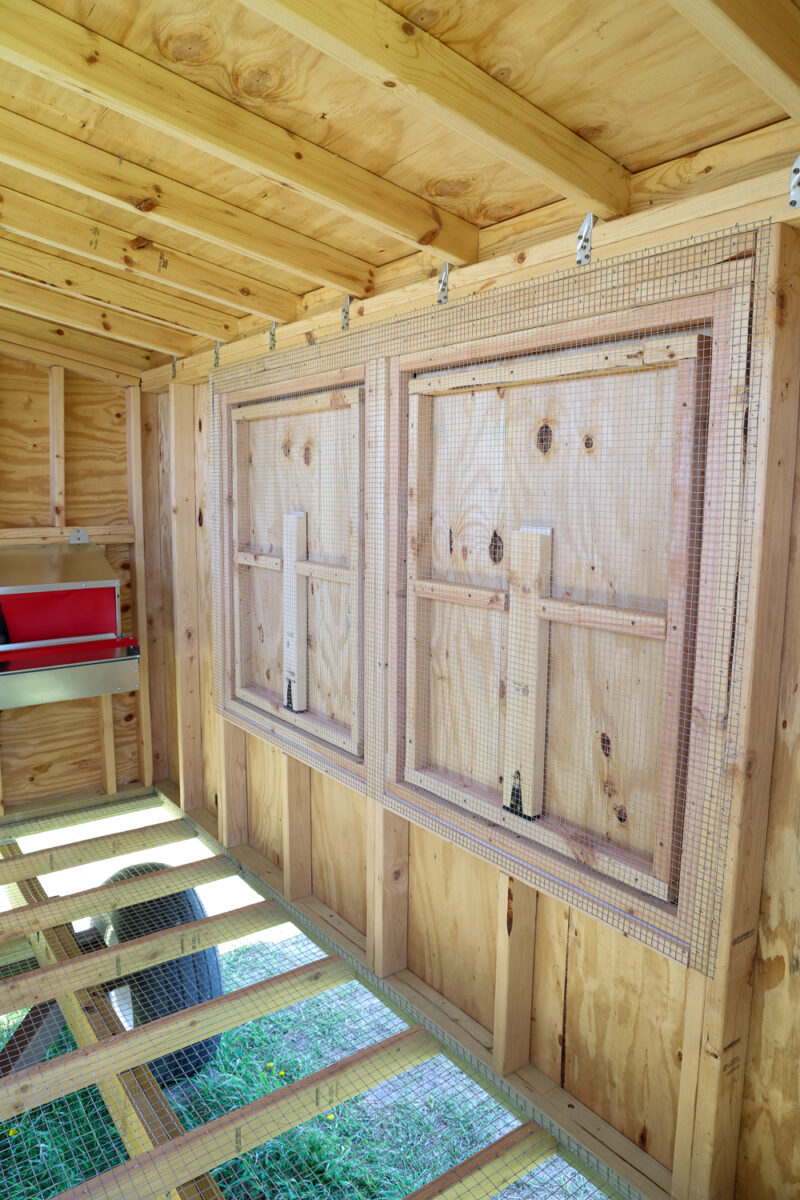
Light
Chickens love sunlight. While they’ll be spending much of their day outside of the coop, it’s still important to plan for windows to allow in light.
We found some antique 6 pane windows and installed 5 of them in our coop. They are fixed, so they don’t open. But they look great and keep things bright in the coop.
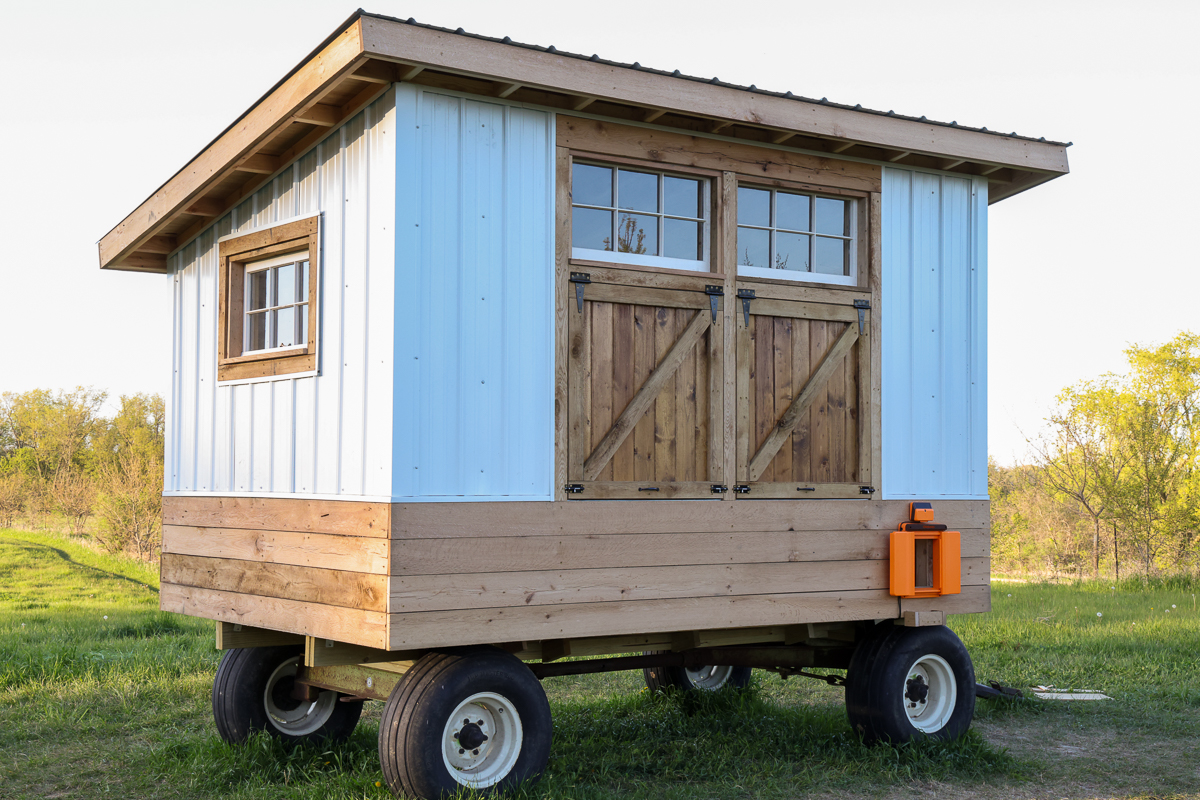
Efficency
Chicken chores happen daily. Designing an efficient coop to keep those chores minimal will save you countless hours in the long run.
We placed our food and water at the front of the coop, right by the door, for easy access. Roosting bars make up the majority of space in the coop and we went with a simple ladder design that forms a V leading down to the center plank. And the laying boxes are at the back of the coop, where it’s the most quiet and secluded for privacy.
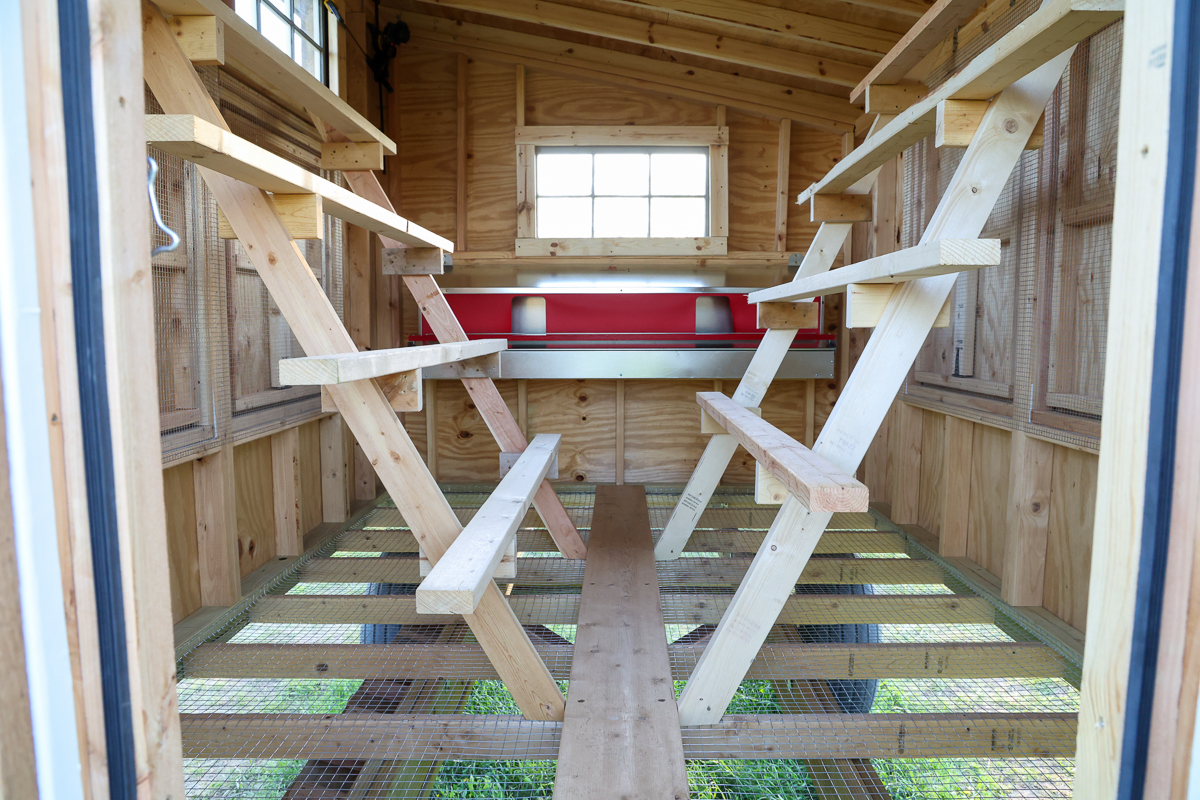
Predator Proofing
A top consideration for any chicken coop is keeping predators out. Our post, Predator Proofing Essentials You Need to Know, goes into much more depth. But you’ll want to make sure you’ve sealed up your egg mobile entirely.
We added blocks between the roof rafters to seal them tight. Hardware cloth keeps the panels and flooring secure. Our solar chicken door adds security by automatically closing up as the sun sets each night. Even if we’re out for the evening, we don’t have to worry about our girls being closed up tight at night.

What is Needed to Build an Egg Mobile?
1. Running Gear
Running gears are essentially a big farm trailer that you can build just about anything on top of. They commonly come in the form of hay wagons. But if you plan to build an open floor egg mobile, just a bare running gear is all you need.


Here’s what you need to know about running gears:
- They have a weight rating in tons. Mine is a 10 ton running gear. The bigger the coop you build, the beefier the running gear you’ll want.
- The length can be adjusted. The center spine on the frame can be extended or retracted. Mine was around 10’ long, and I extended it an extra 18” for our 12’ long coop.
- Look for good tires. The standard implement tires are robust and can generally last a long time, even after they’ve started dry rotting. But replacing those tires can be $150-200 each. Some also opt for truck tires on their running gear.
- Give it an inspection. Does the front axle turn freely? Is the tongue and frame straight and not bent up? This is your foundation. If you’re going through the trouble of building a sweet chicken coop on top of this thing, you want to make sure it will last.


2. Runners or Beams
On top of your running gear, you’ll need some sort of runners or beams for the platform of the chicken coop to sit on. I sistered together two treated 2×6’s for these runners. Then I bolted them to the 90° angle brackets on the running gear using 1/2” carriage bolts.
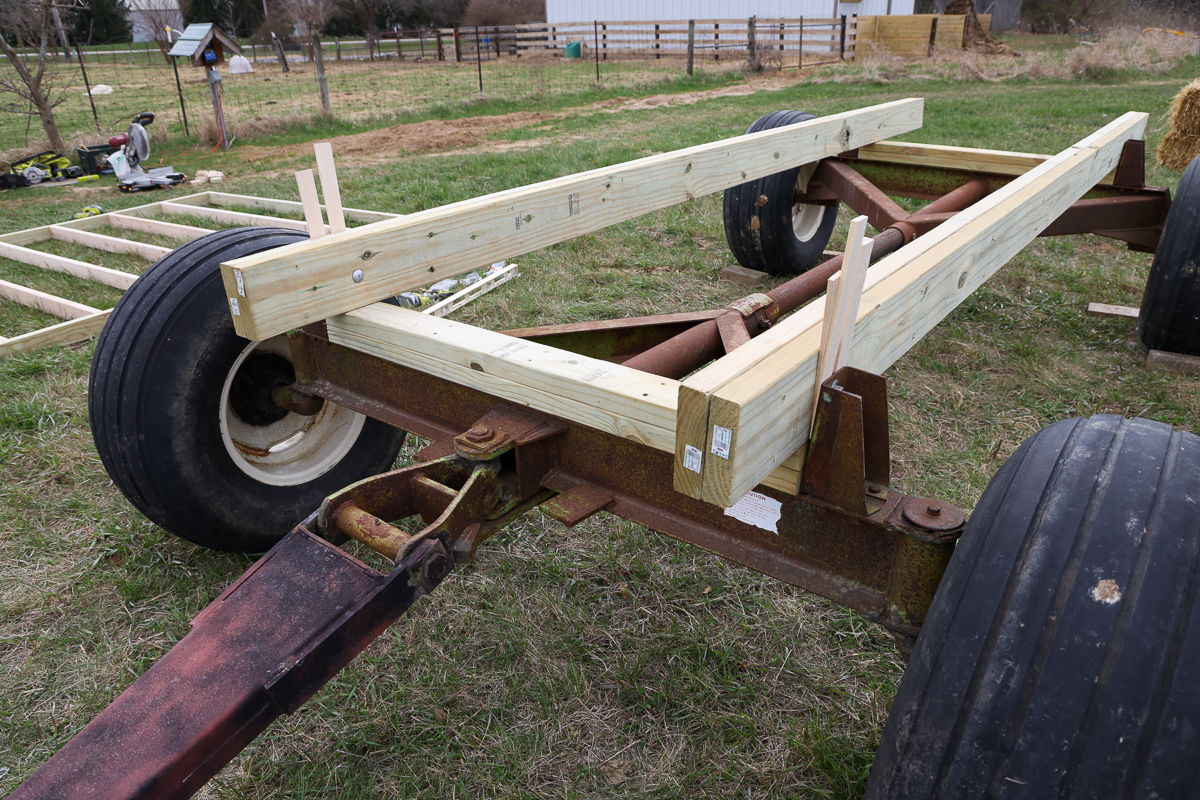
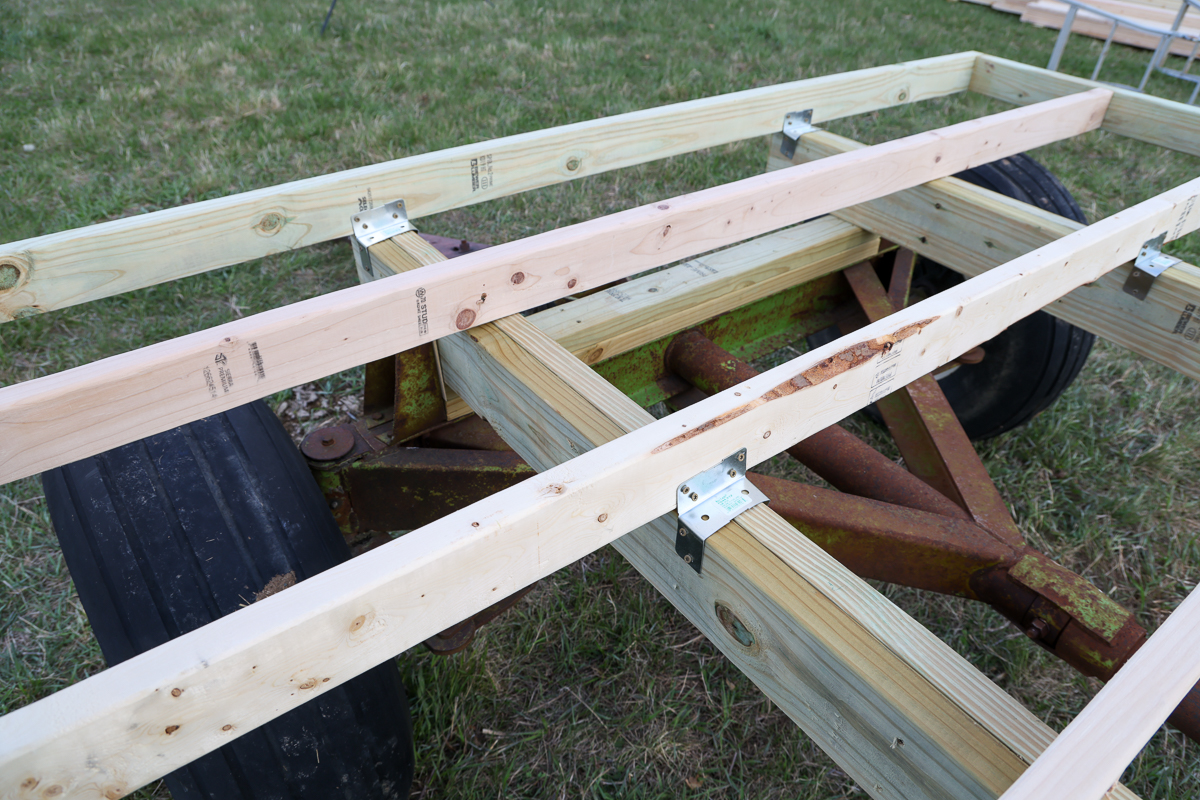
Now, had I measured the running gear ahead of time, I would have used 2×8’s instead for the runners. The 2×6’s wouldn’t allow for the platform of the coop to clear the wheels, so I needed to raise them up with some treated 2×4’s. Plus, the chicken coop ended up weighing A LOT, and the 2×8’s would have been better suited overall for that load.
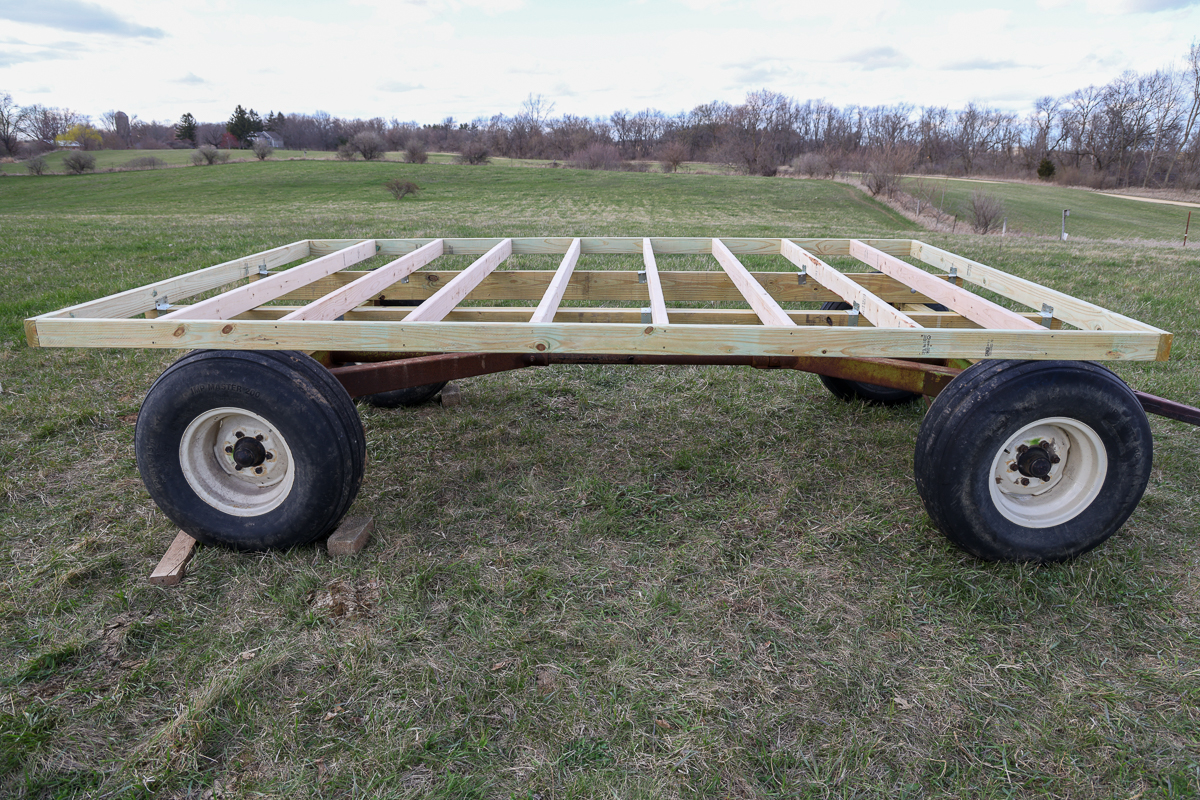

3. Framing Materials
I used pretty standard 2x framing for our mobile coop. It’s a big structure, so pick up some extra 2×4’s just to have on hand. Especially some extra long ones that you can use for diagonal bracing when setting up the wall initially.
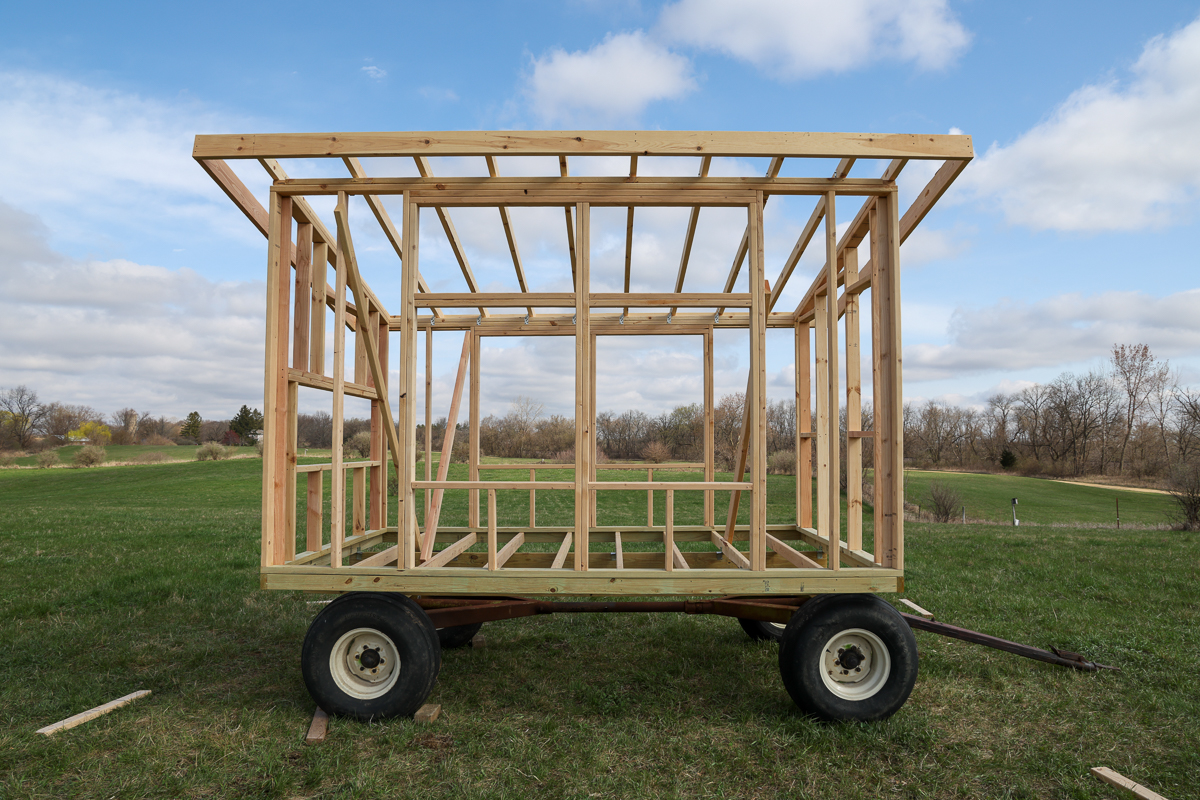
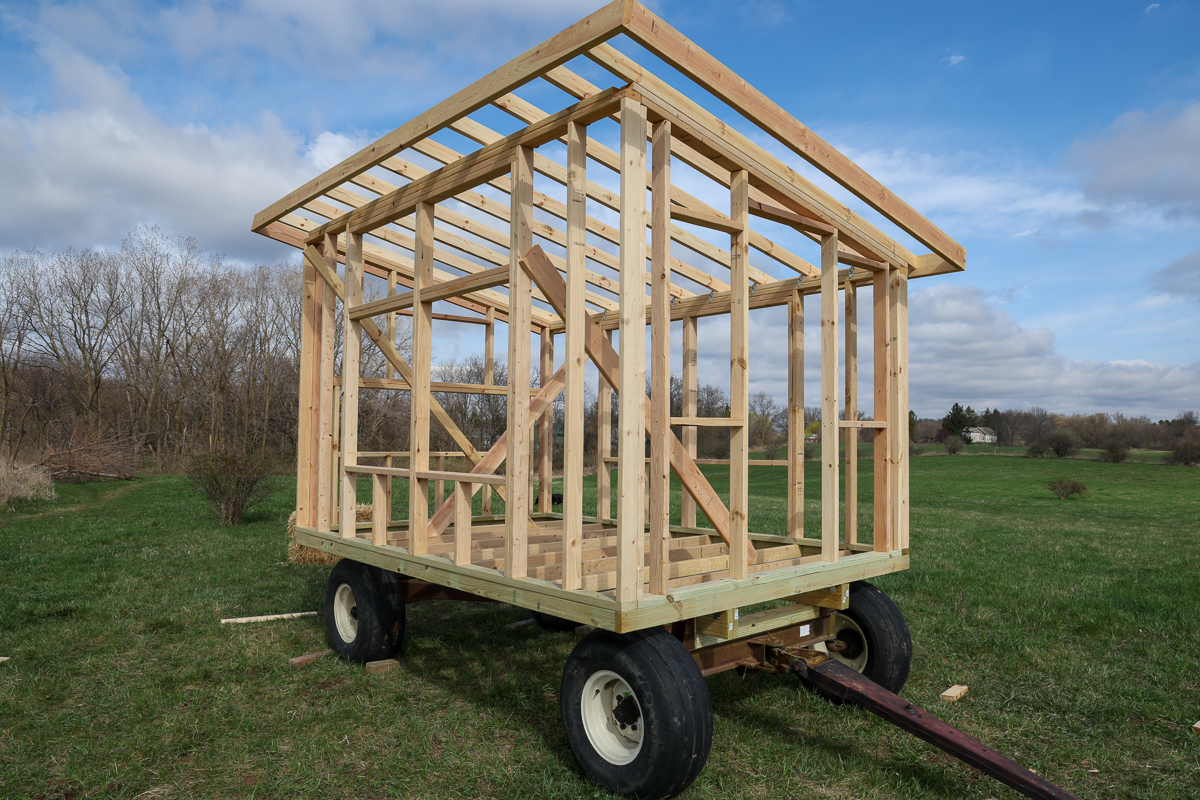
4. Plywood and Wrapping
I opted to wrap the walls and roof of our coop in plywood, but this isn’t necessary. The siding and roofing can go directly on your framing. However, I planned to overwinter our chickens in our egg mobile, so I wanted to make it as weather-tight as possible, which the plywood helps with.
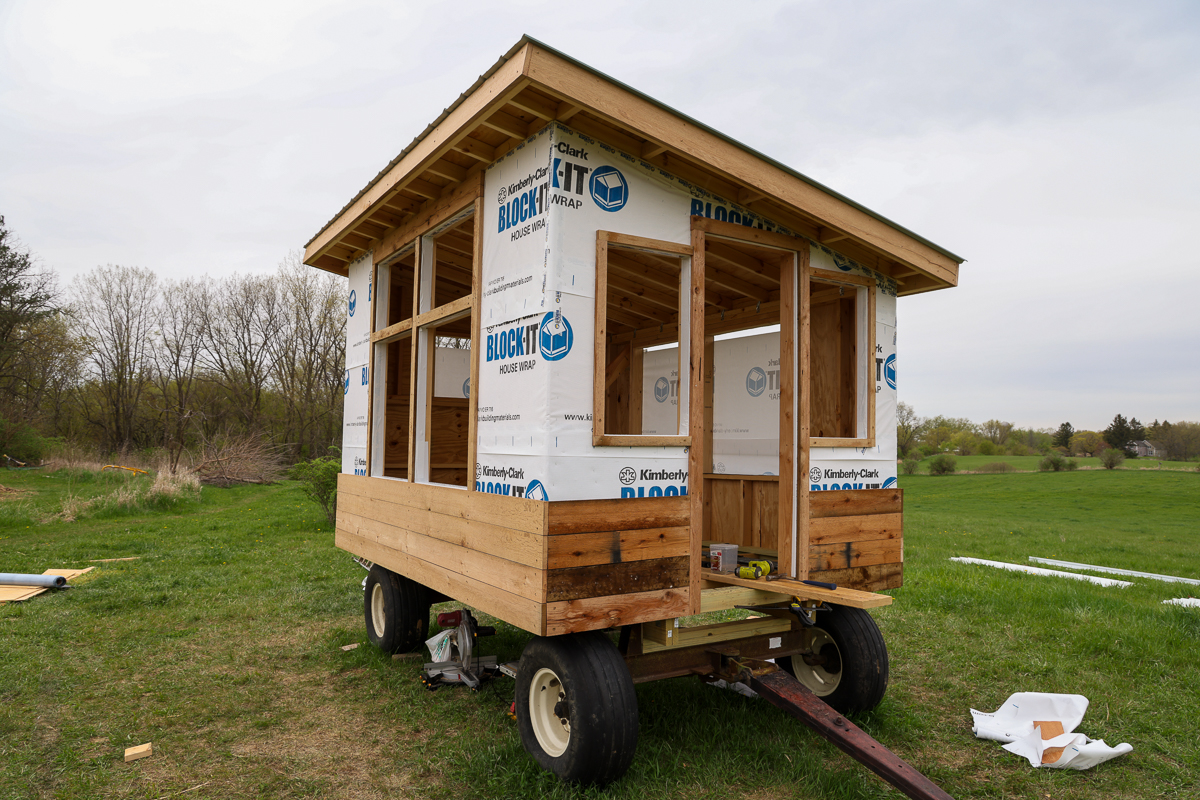
If you do go with plywood, just make sure you have a plan for how to protect that plywood from the elements. I ended up wrapping all the plywood with a house wrap moisture barrier, and then taping up all the openings with a heavy duty flashing tape.
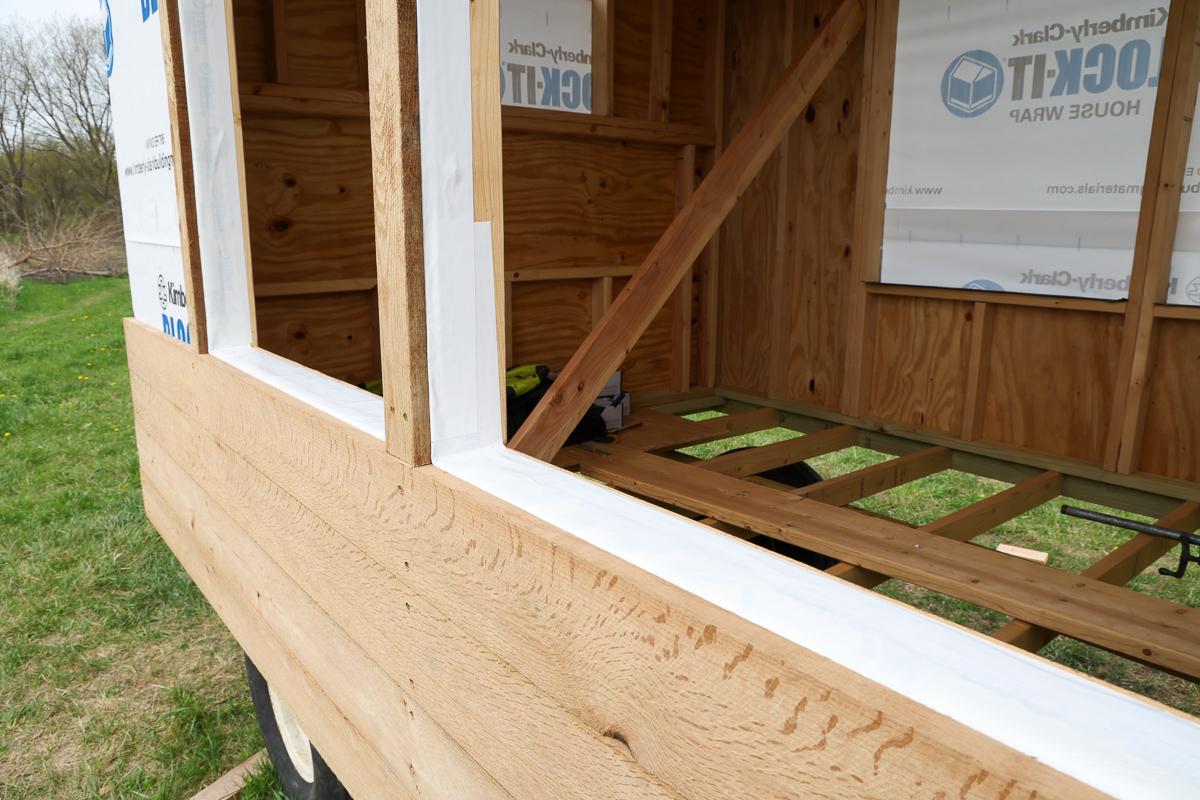

I did consider insulating the wall cavities and then lining the interior walls of the coop with something like old corrugated barn tin panels. However, I decided to hold off on this since I didn’t want mice and insects to take up residence in the walls and insulation.
5. Siding and Roofing
Have fun customizing the look of your egg mobile! I wanted a clean look of white metal siding blended with natural wood accents.
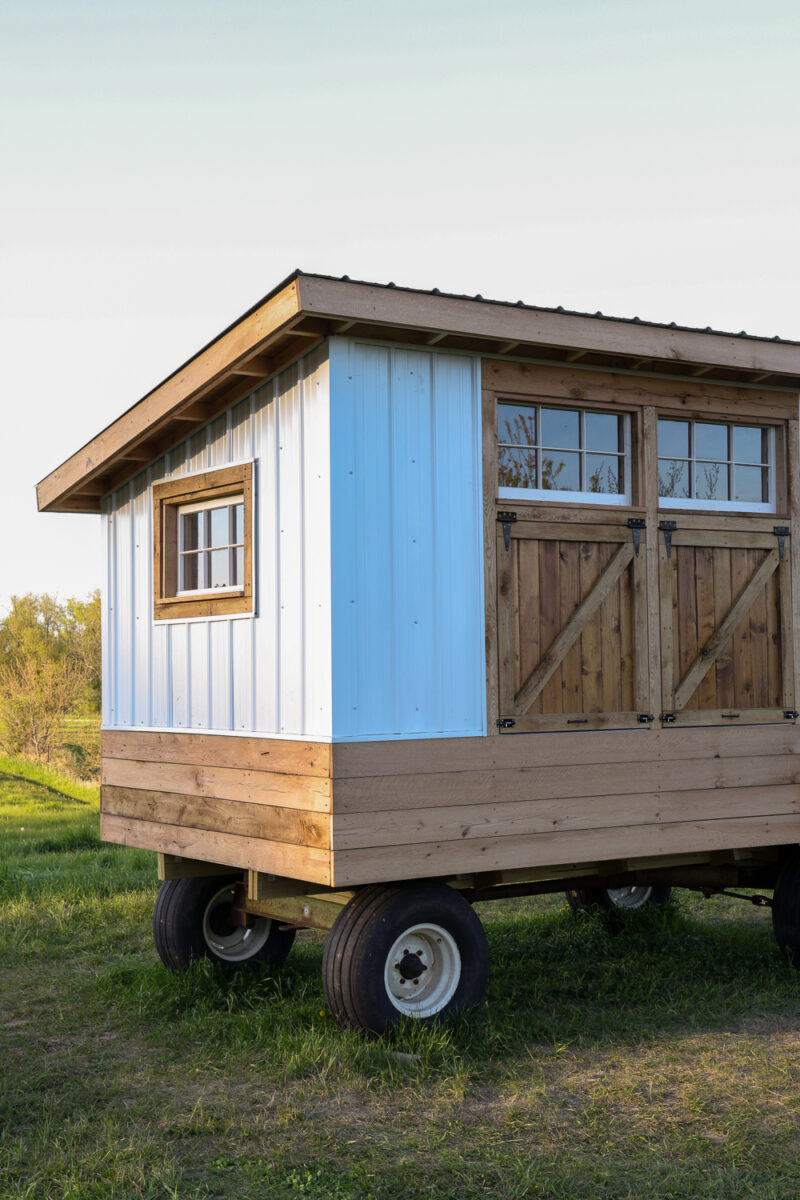
We did 2’ of horizontal oak boards along the base of the coop, and also ripped down those oak boards to trim out the windows and panels. Some lumber yards carry 16’ oak fence boards, and I love using them for projects. They give that sweet rough sawn look and hold up really well to the elements.
We picked up Pro Rib metal panels and used white for the siding and green for the roof.
6. Hardware
Whatever hardware you go with, just make sure it’s heavy duty and rated for outdoor use. I went with exterior grade, heavy duty black hinges, barrel locks, and handles for the door and panels. Those panels ended up weighing a lot, so heavy duty was the way to go.
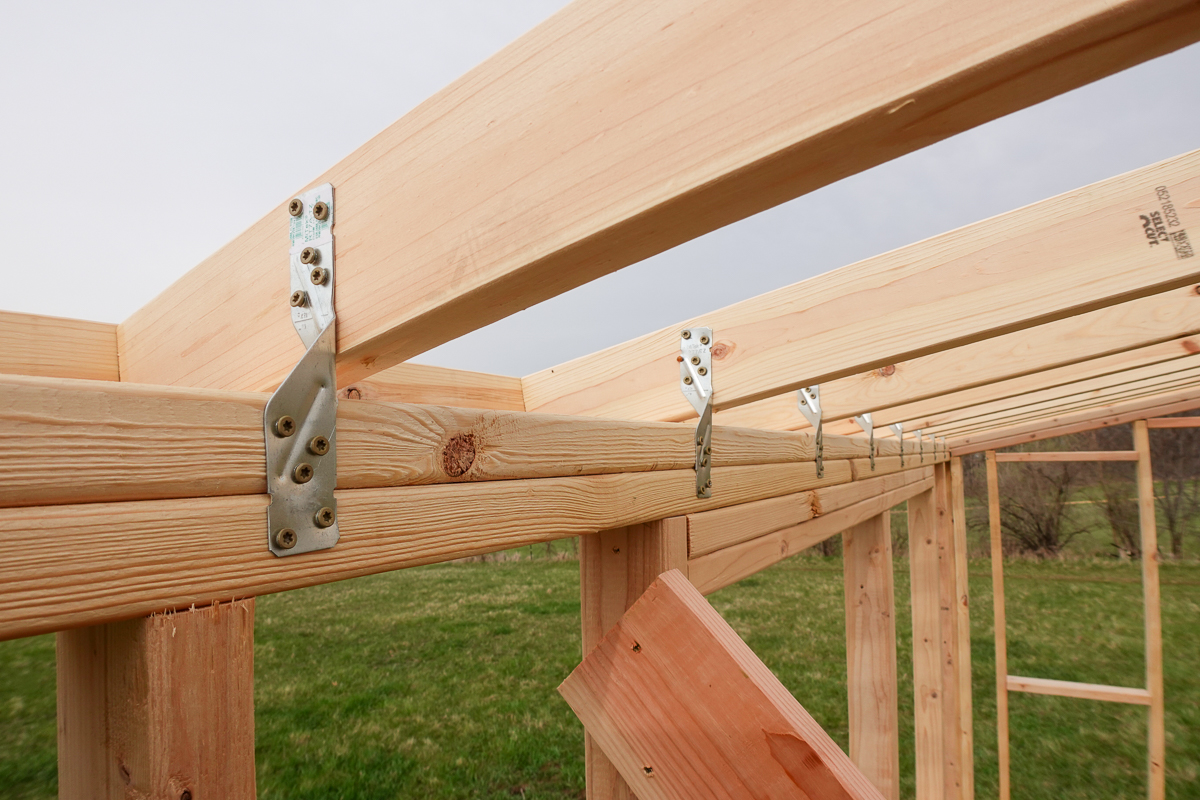
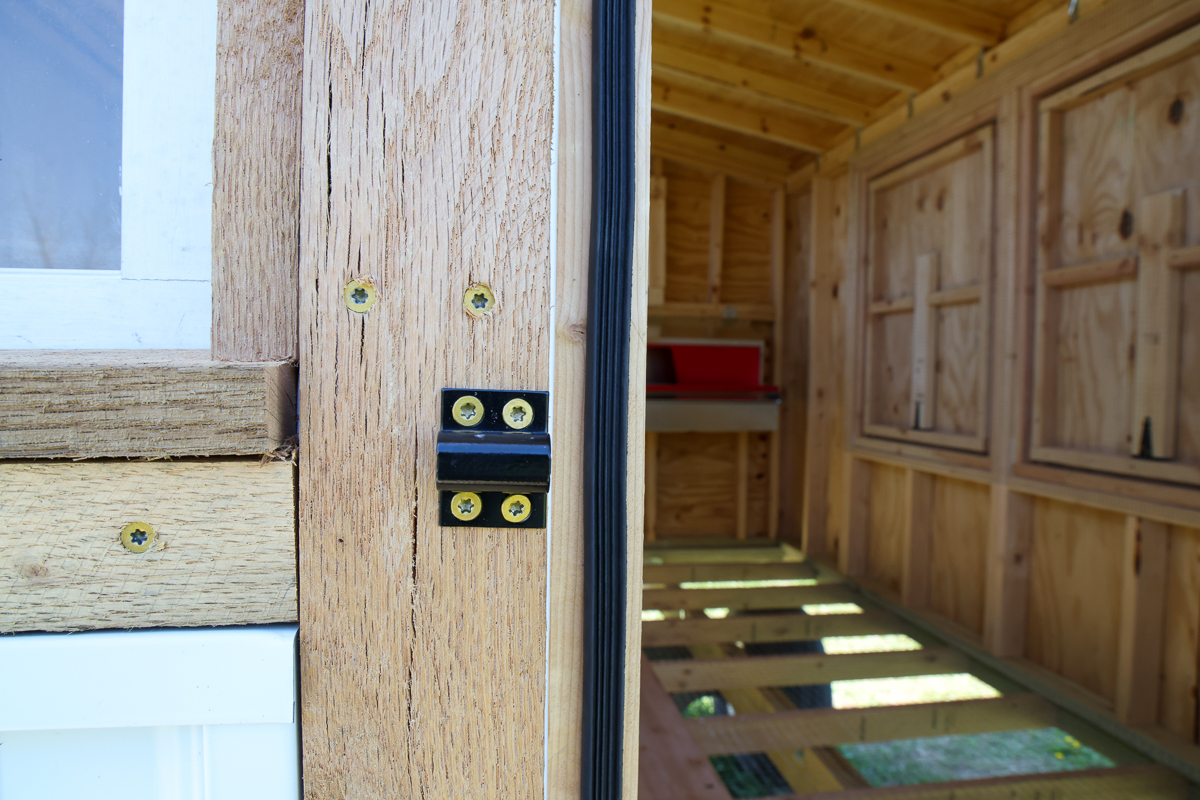
For fastening in the oak boards, I also opted for premium construction screws. They were gold coated, which left a nice finish look for both the wood and hardware.
7. Flooring
I can’t stress enough that you want to get the flooring right. I liked the 1”x1” hardware cloth that I ended up going with. It was a heavier gauge than normal 1/2” hardware cloth, so it feels pretty substantial.
My biggest question was how it would stand up to people foot traffic. If it wasn’t sturdy enough, my plan was to secure down some cattle panel on top of it for extra support. Since most of the foot traffic is on the center 2×10 plank, I ended up just going with the 1” hardware cloth.
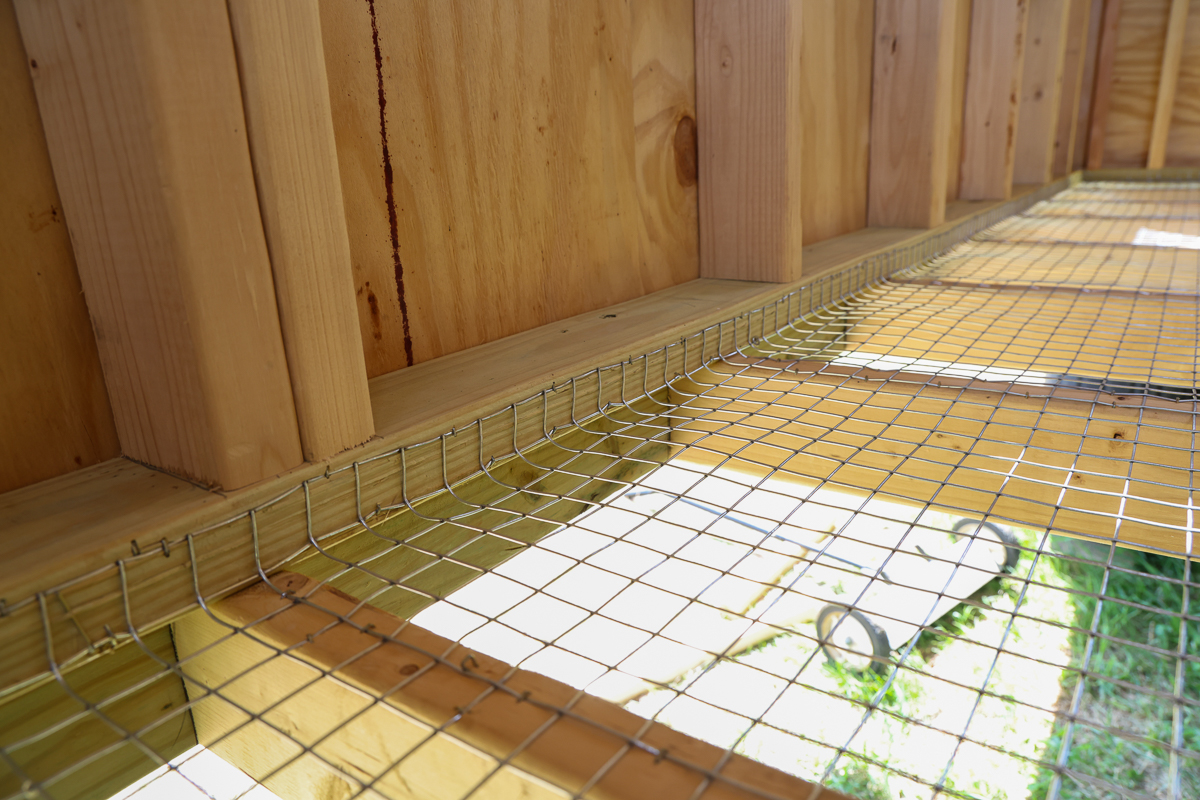
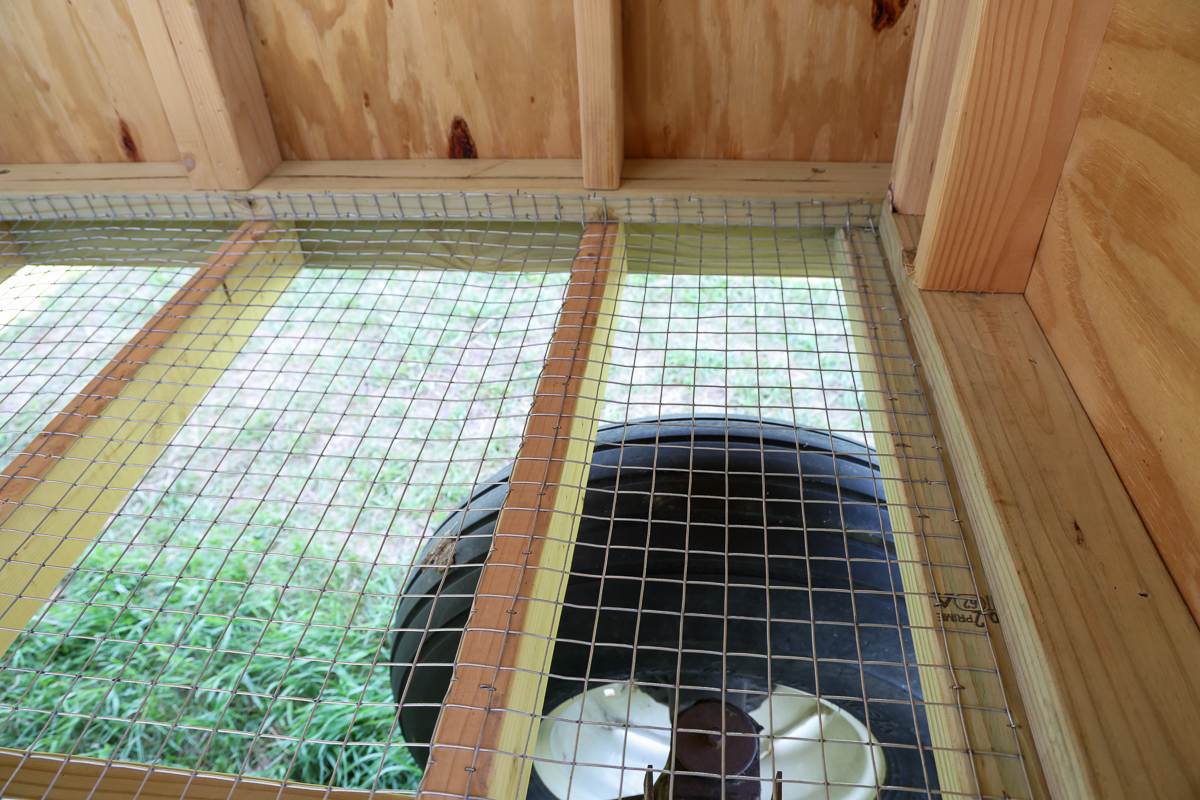
8. Laying Boxes
We went with the XL Hen Gear Rollout Nesting Box and love it! It was so nice to get to this stage of the project and not have another thing to figure out and build. Assembly was easy and the design and build quality are awesome.
After chickens lay, the eggs roll down into a collection tray so they stay clean and don’t get pecked at. We opted to install the collection tray on the inside of the coop, but you can also reverse it so eggs can be collected from the outside.
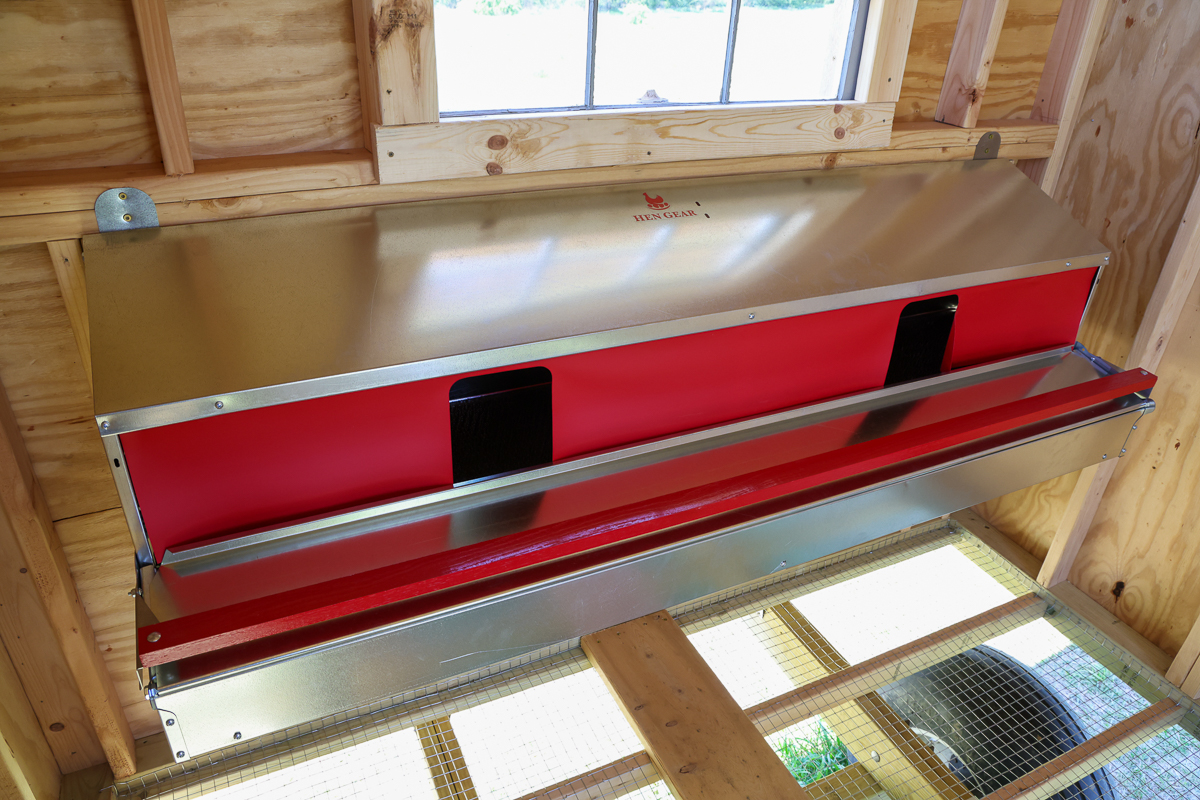
9. Automatic Chicken Door
I honestly don’t know how we didn’t invest in one of these solar powered automatic chicken doors on our coops sooner. But it for sure made sense to put one on our egg mobile.
And this one from Chickcozy is the bee’s knees. The built-in light sensor allows you to program it to open with the sunrise and close with the sunset, so it adapts with the seasons. Ours has worked flawlessly and we sleep easy each night knowing our chickens are safe and secure, whether we’re home or away.
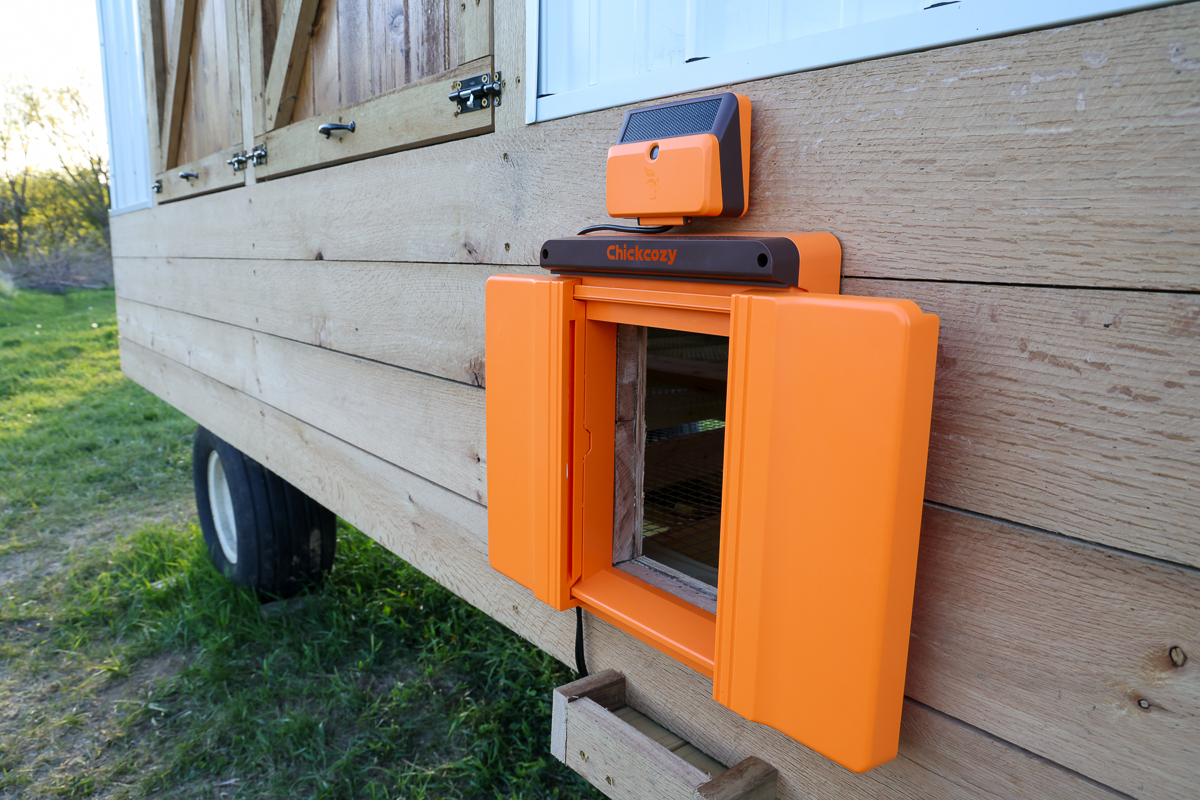
10. Roosting Bars
We go into more depth in our post on roosting bars. But we stuck with a pretty standard ladder design. In the end, we have 8 roosting bars, four on each side, that 6’ long. The bars were spaced 16” apart and ended up being at about a 60° angle relative to the ground.
They’re a little closer together than I’d prefer, given the compact footprint I was working in. But so far, it seems to be working well with the chickens.
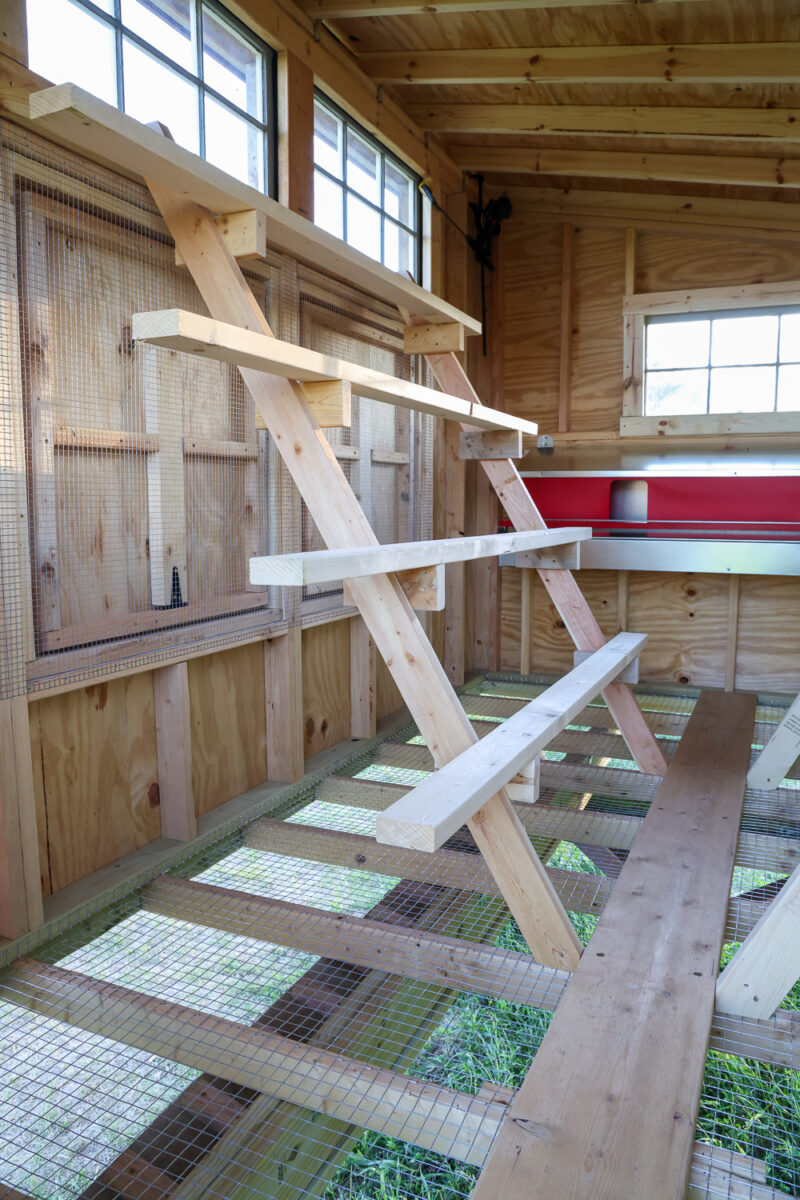
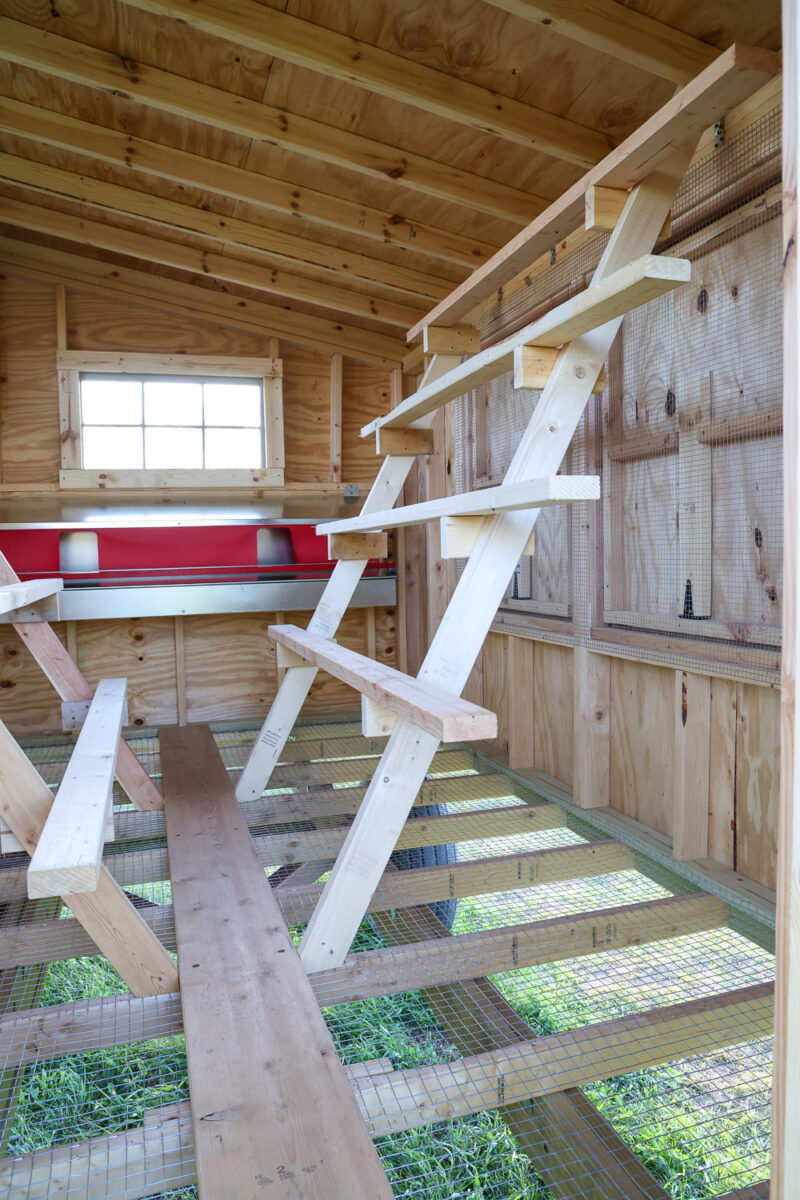
Are there downsides to an egg mobile?
The mobile nature of egg mobiles makes for some additional logistics to figure out along the way. Overall, I think the pros far outweigh the cons, but here are some potential downsides to consider.
Overwintering
One of the things I thought long and hard about is how in the world—especially with the floor wide open—will I make this coop work in the winter in our northern climate?
One, I sealed it really good. I mentioned the plywood and blocking to close everything tight. I also added foam weatherstripping at the air vent panels and door, and around the window sills, so everything seals up tight.
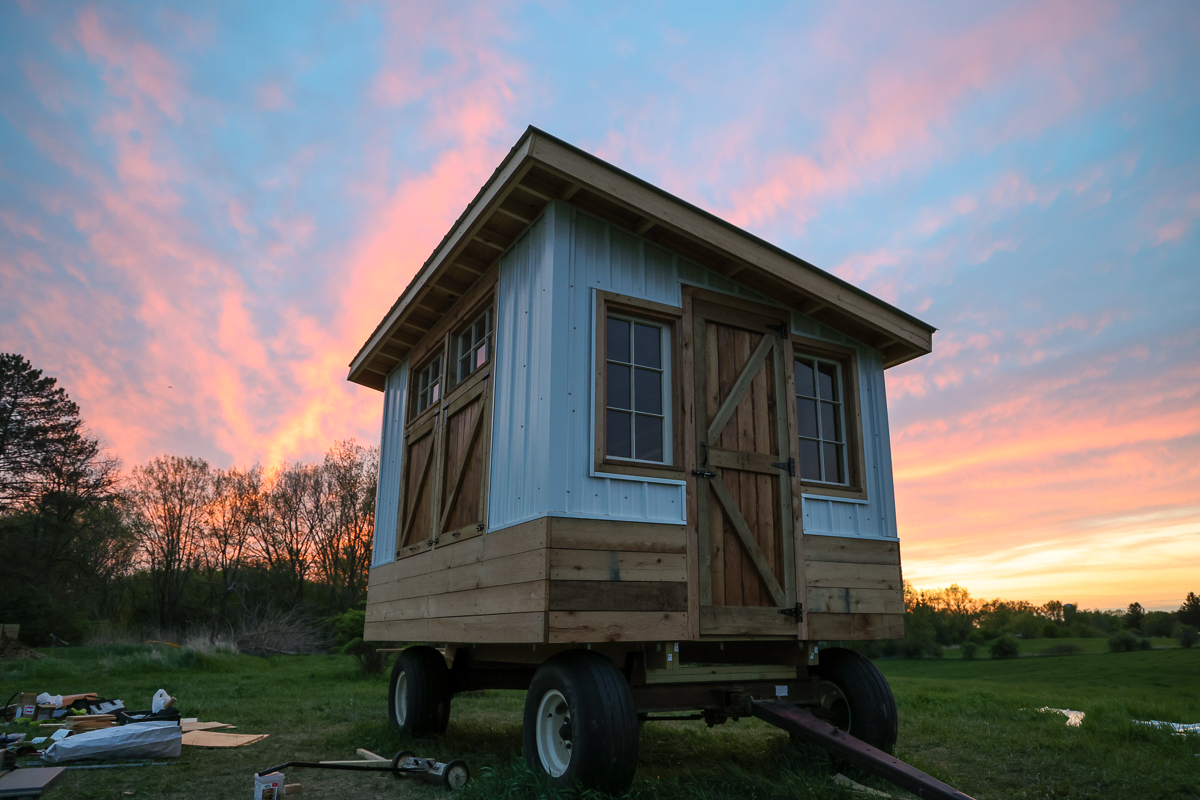
But the floor—it’s still wide open! Initially, I thought I’d just put a good straw layer on the floor of the coop. But that would make a mess in the coop and defeat the purpose of the open floor design.
My thought as of now is to get a bunch of straw bales to stack high around the entire perimeter of the coop. This would basically close up and insulate the space between the ground up to the coop, but still leave the floor open.
Moving It
Yes, a mobile chicken coop only works properly when it’s moved regularly. So, you need something to easily pull it with, relatively flat and open land, and the time to relocate your whole setup when necessary.
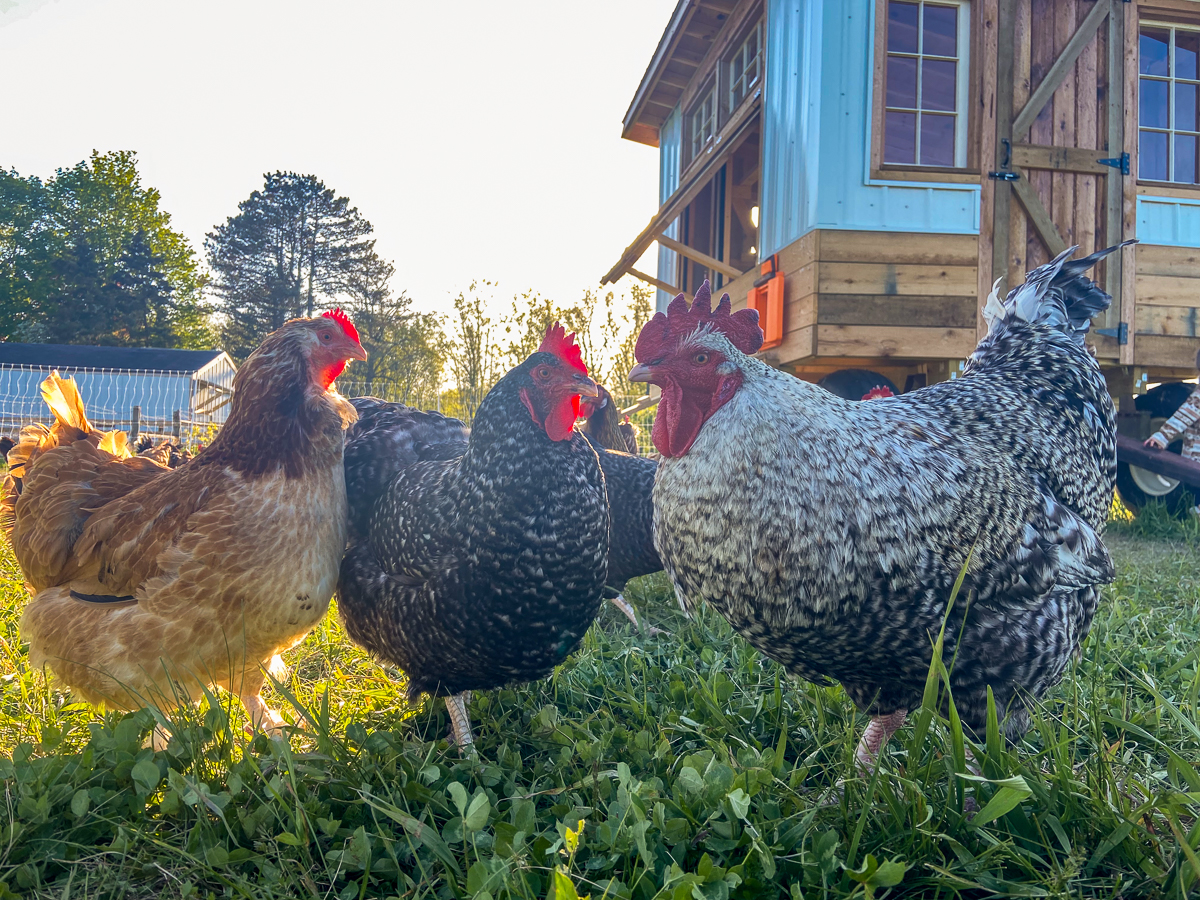
We’re in the beginning stages of moving our coop with our tractor and integrating our chickens into our rotational grazing system. Like most anything, I suspect it will feel like a challenge early on, but as we work through the logistics, the process will get easier and streamlined over time.
Keeping Chickens Contained
If your chickens were previously free ranging like ours, they may not take too well to suddenly being contained within fencing. Thankfully, the 48” high poultry netting from Premier One has done the trick so far for us, with only a couple jailbreaks. But we’ve heard from others that this didn’t work and they needed to clip their chickens’ wings to keep them in the fencing.
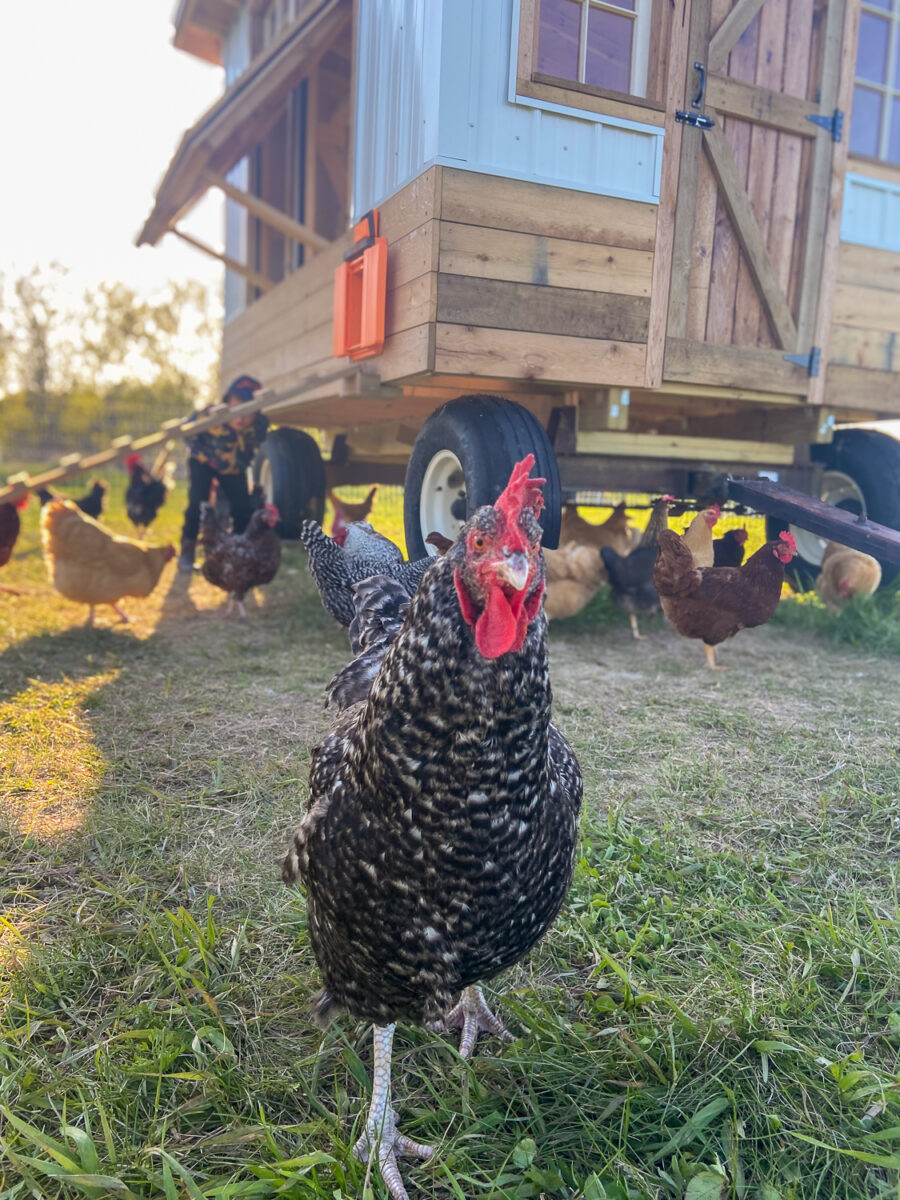
Cost
Building an egg mobile can be a substantial investment for your farm or homestead. Let’s take a look at what ours cost.
What Does an Egg Mobile Cost to Build?
A typical egg mobile will cost in the $1,500-$6,000 range to build. You can use things like reclaimed materials, pallets, old barn tin, etc. and build a very budget friendly egg mobile to stay near the low end of that price range.
But regardless, you still need a running gear, materials, hardware, fasteners, and maybe even some tools along the way. The size of your coop will also factor into the overall cost.
Our egg mobile came in at the higher end of that price range. Here is a spreadsheet where I totaled up all the costs.
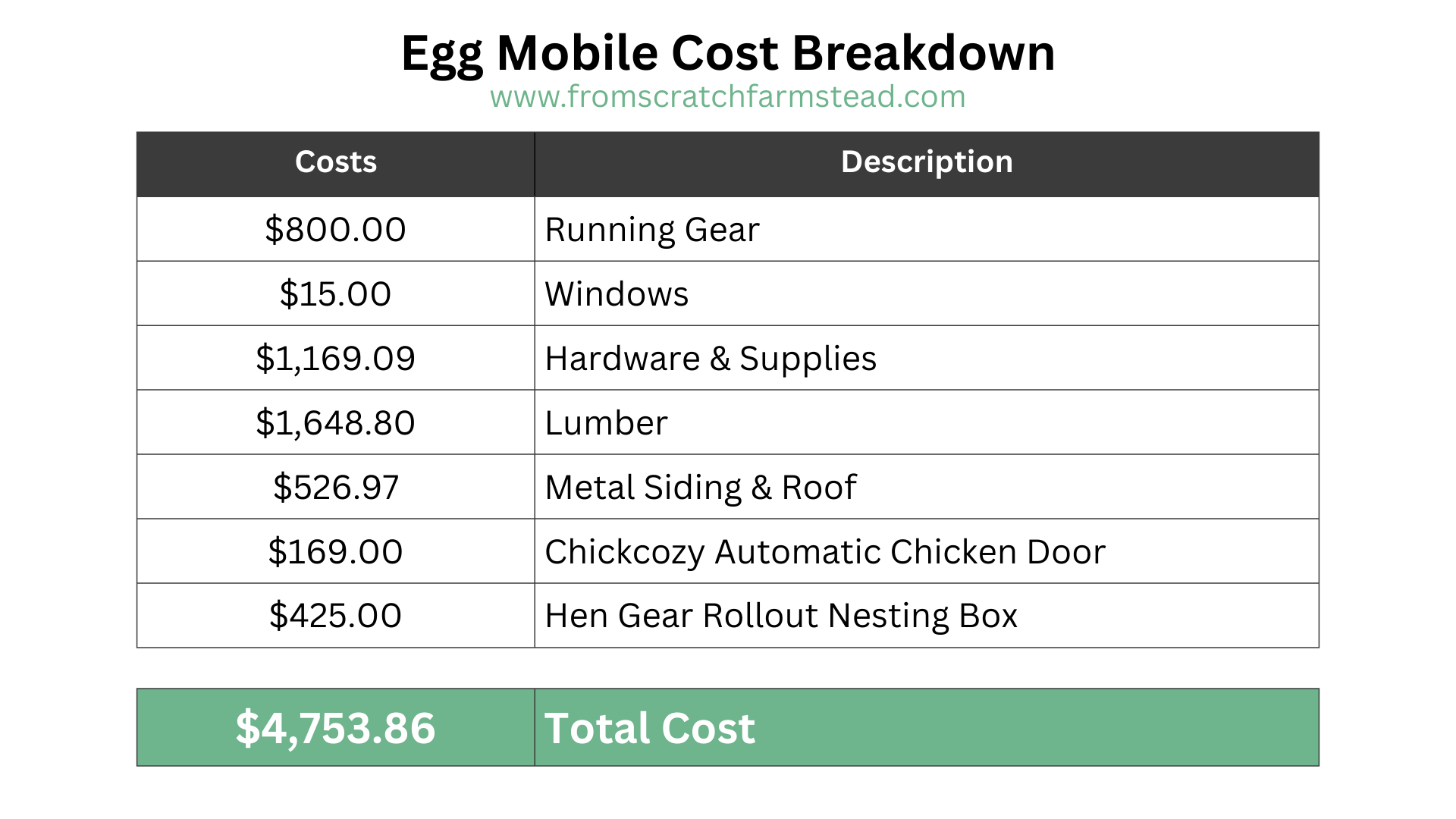
It wasn’t our goal to build on a budget with this project. We wanted something that looked nice and would last us a long time.
We’re thrilled with the end results! This egg mobile is a fantastic addition to our small homestead.
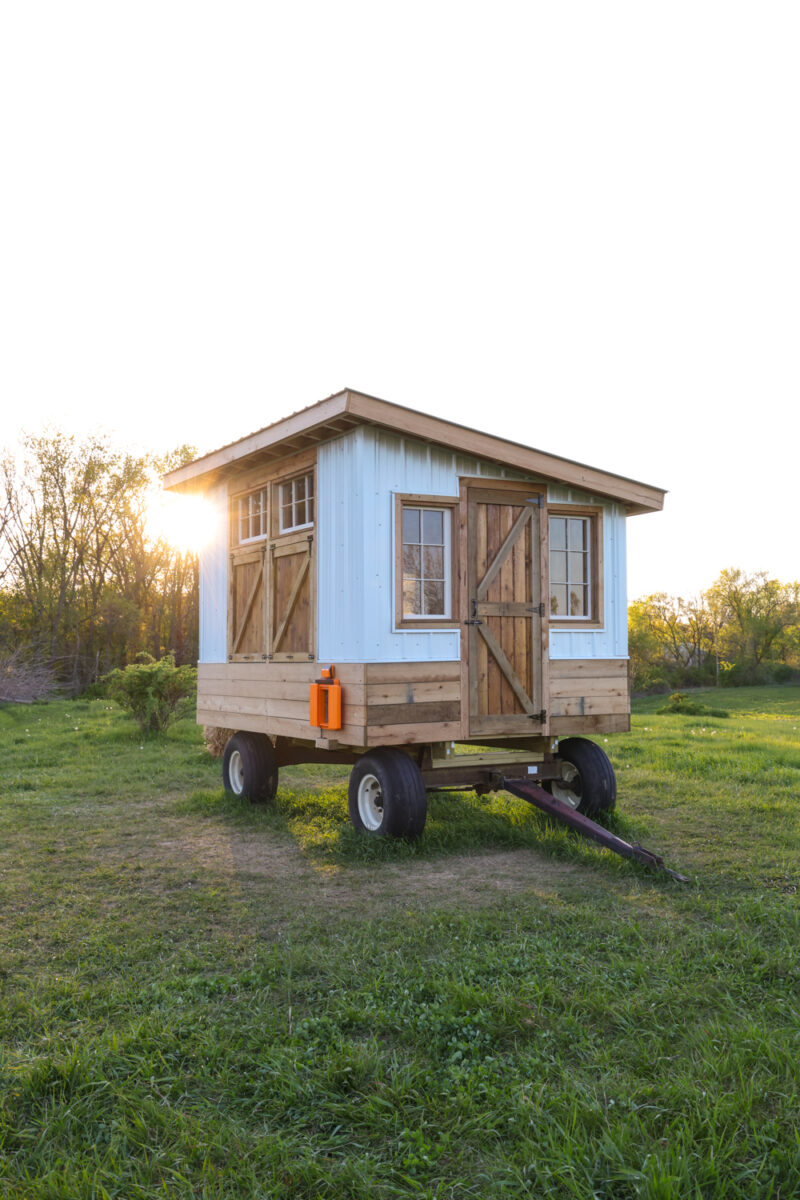
Have you built your own egg mobile? What did it cost? What tips do you have for others starting their own mobile chicken coop adventure?
More on Backyard Chickens:
What Should Be Inside a Chicken Coop – Easy Guide!
Predator Proof Chicken Coop Essentials You Need To Know
Custom A-Frame Chicken Tractor for (Almost) Free
Simple DIY Chicken Coop Inside Your Barn
Breaking Down the Cost of Chickens for Eggs
Chicken Tractor Plans for 25 Meat Chickens
Some of the above links are affiliate links. This means we earn a small commission at no cost to you. We are so appreciative of your support!
Pin it for later!







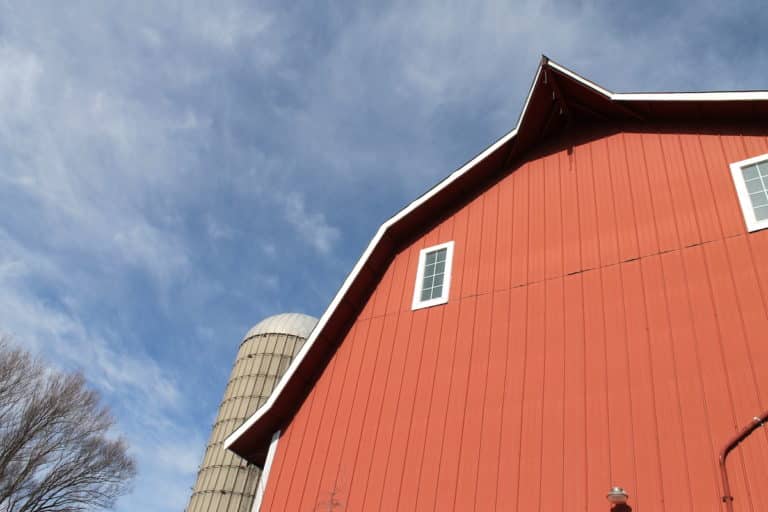
Nice chicken tractor! I am about to build a similar one. Is the 1″ mesh floor still doing as well as expected?
Thanks! Yes, I’m still happy I went the 1″ hardware cloth route. After several months there is literally zero poop buildup on the mesh floor. It really isn’t even bad where the joists run. Any poop that lands there, the chickens kick it around and it eventually falls through. The one thing I’ll need to do every now and again is clear off any buildup on top of the double wide runners below – that’s the one area its starting to build but hasn’t been an issue. The one thing I will say about the hardware cloth is that is does stretch some over time. I tried to get it as tight as possible when installing, which was a challenge. But from foot traffic there’s a decent sag in it now. Good luck to you!